Database Assignment: Designing a Relational Database System for VET Solution Company
VerifiedAdded on 2024/05/21
|42
|4665
|372
AI Summary
This report details the design and implementation of a relational database system for VET Solution, a veterinary company in Cambridge. The database is designed to manage patient records, staff information, appointments, prescriptions, and branch details. The report covers the design process using ER diagrams, data normalization, and data validation. It also includes the development of the database using MS SQL Server 2014, with examples of queries across multiple tables. The report concludes with a discussion of system security, database maintenance, and testing procedures.
Contribute Materials
Your contribution can guide someone’s learning journey. Share your
documents today.

Database Assignment
Secure Best Marks with AI Grader
Need help grading? Try our AI Grader for instant feedback on your assignments.
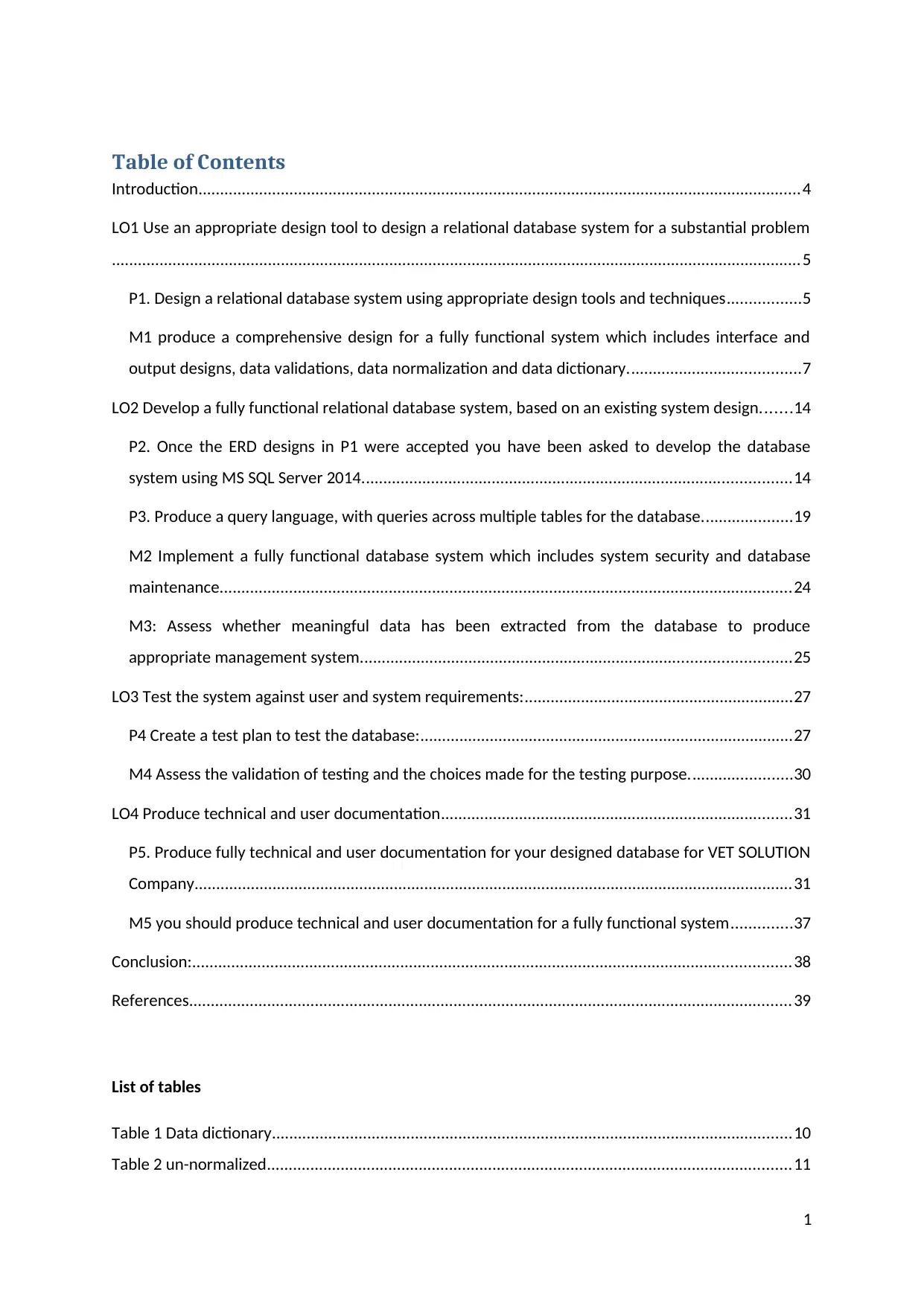
Table of Contents
Introduction...........................................................................................................................................4
LO1 Use an appropriate design tool to design a relational database system for a substantial problem
...............................................................................................................................................................5
P1. Design a relational database system using appropriate design tools and techniques.................5
M1 produce a comprehensive design for a fully functional system which includes interface and
output designs, data validations, data normalization and data dictionary........................................7
LO2 Develop a fully functional relational database system, based on an existing system design.......14
P2. Once the ERD designs in P1 were accepted you have been asked to develop the database
system using MS SQL Server 2014...................................................................................................14
P3. Produce a query language, with queries across multiple tables for the database.....................19
M2 Implement a fully functional database system which includes system security and database
maintenance....................................................................................................................................24
M3: Assess whether meaningful data has been extracted from the database to produce
appropriate management system...................................................................................................25
LO3 Test the system against user and system requirements:..............................................................27
P4 Create a test plan to test the database:......................................................................................27
M4 Assess the validation of testing and the choices made for the testing purpose........................30
LO4 Produce technical and user documentation.................................................................................31
P5. Produce fully technical and user documentation for your designed database for VET SOLUTION
Company..........................................................................................................................................31
M5 you should produce technical and user documentation for a fully functional system..............37
Conclusion:..........................................................................................................................................38
References...........................................................................................................................................39
List of tables
Table 1 Data dictionary........................................................................................................................10
Table 2 un-normalized.........................................................................................................................11
1
Introduction...........................................................................................................................................4
LO1 Use an appropriate design tool to design a relational database system for a substantial problem
...............................................................................................................................................................5
P1. Design a relational database system using appropriate design tools and techniques.................5
M1 produce a comprehensive design for a fully functional system which includes interface and
output designs, data validations, data normalization and data dictionary........................................7
LO2 Develop a fully functional relational database system, based on an existing system design.......14
P2. Once the ERD designs in P1 were accepted you have been asked to develop the database
system using MS SQL Server 2014...................................................................................................14
P3. Produce a query language, with queries across multiple tables for the database.....................19
M2 Implement a fully functional database system which includes system security and database
maintenance....................................................................................................................................24
M3: Assess whether meaningful data has been extracted from the database to produce
appropriate management system...................................................................................................25
LO3 Test the system against user and system requirements:..............................................................27
P4 Create a test plan to test the database:......................................................................................27
M4 Assess the validation of testing and the choices made for the testing purpose........................30
LO4 Produce technical and user documentation.................................................................................31
P5. Produce fully technical and user documentation for your designed database for VET SOLUTION
Company..........................................................................................................................................31
M5 you should produce technical and user documentation for a fully functional system..............37
Conclusion:..........................................................................................................................................38
References...........................................................................................................................................39
List of tables
Table 1 Data dictionary........................................................................................................................10
Table 2 un-normalized.........................................................................................................................11
1
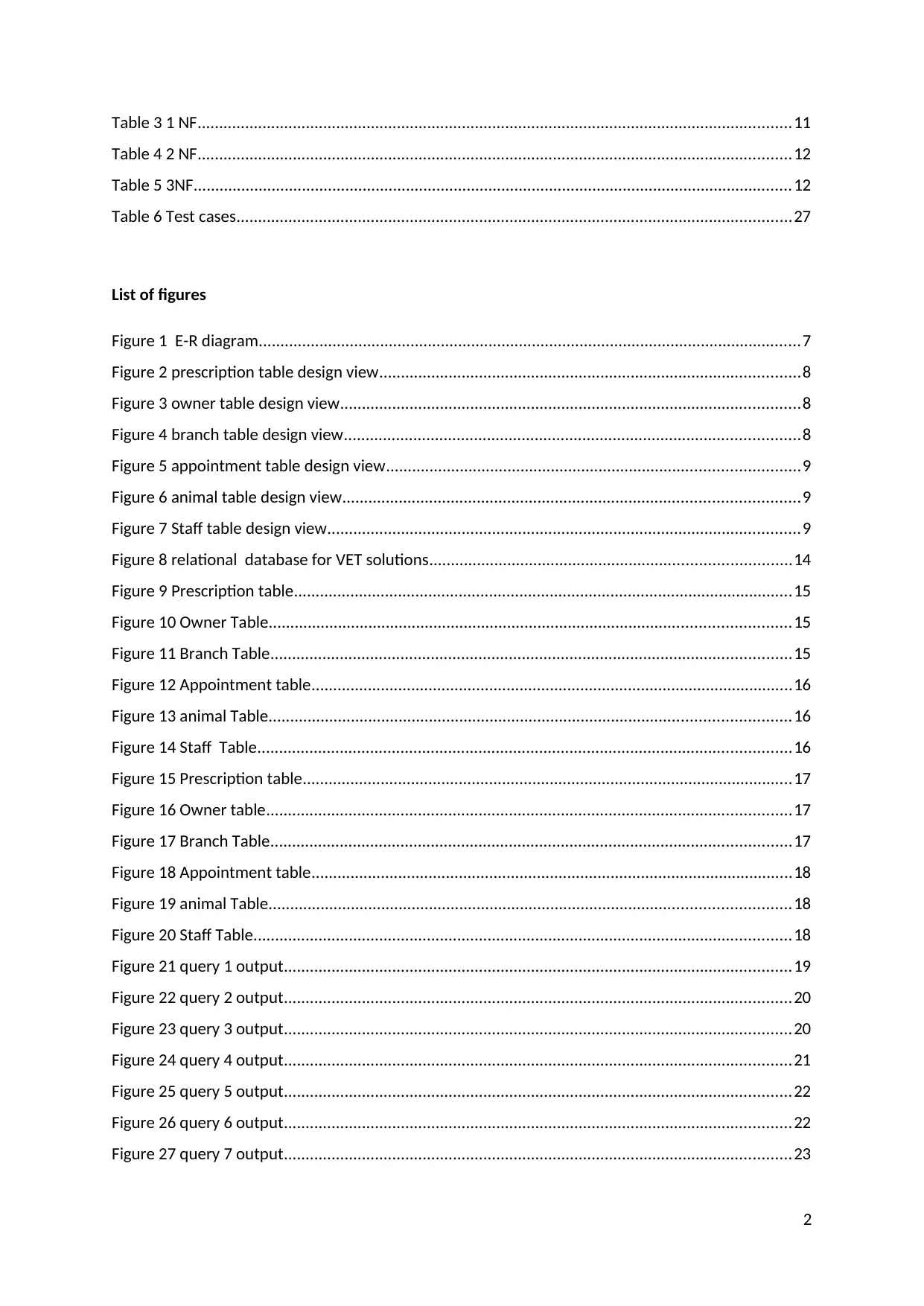
Table 3 1 NF.........................................................................................................................................11
Table 4 2 NF.........................................................................................................................................12
Table 5 3NF..........................................................................................................................................12
Table 6 Test cases................................................................................................................................27
List of figures
Figure 1 E-R diagram.............................................................................................................................7
Figure 2 prescription table design view.................................................................................................8
Figure 3 owner table design view..........................................................................................................8
Figure 4 branch table design view.........................................................................................................8
Figure 5 appointment table design view...............................................................................................9
Figure 6 animal table design view.........................................................................................................9
Figure 7 Staff table design view.............................................................................................................9
Figure 8 relational database for VET solutions...................................................................................14
Figure 9 Prescription table...................................................................................................................15
Figure 10 Owner Table........................................................................................................................15
Figure 11 Branch Table........................................................................................................................15
Figure 12 Appointment table...............................................................................................................16
Figure 13 animal Table........................................................................................................................16
Figure 14 Staff Table...........................................................................................................................16
Figure 15 Prescription table.................................................................................................................17
Figure 16 Owner table.........................................................................................................................17
Figure 17 Branch Table........................................................................................................................17
Figure 18 Appointment table...............................................................................................................18
Figure 19 animal Table........................................................................................................................18
Figure 20 Staff Table............................................................................................................................18
Figure 21 query 1 output.....................................................................................................................19
Figure 22 query 2 output.....................................................................................................................20
Figure 23 query 3 output.....................................................................................................................20
Figure 24 query 4 output.....................................................................................................................21
Figure 25 query 5 output.....................................................................................................................22
Figure 26 query 6 output.....................................................................................................................22
Figure 27 query 7 output.....................................................................................................................23
2
Table 4 2 NF.........................................................................................................................................12
Table 5 3NF..........................................................................................................................................12
Table 6 Test cases................................................................................................................................27
List of figures
Figure 1 E-R diagram.............................................................................................................................7
Figure 2 prescription table design view.................................................................................................8
Figure 3 owner table design view..........................................................................................................8
Figure 4 branch table design view.........................................................................................................8
Figure 5 appointment table design view...............................................................................................9
Figure 6 animal table design view.........................................................................................................9
Figure 7 Staff table design view.............................................................................................................9
Figure 8 relational database for VET solutions...................................................................................14
Figure 9 Prescription table...................................................................................................................15
Figure 10 Owner Table........................................................................................................................15
Figure 11 Branch Table........................................................................................................................15
Figure 12 Appointment table...............................................................................................................16
Figure 13 animal Table........................................................................................................................16
Figure 14 Staff Table...........................................................................................................................16
Figure 15 Prescription table.................................................................................................................17
Figure 16 Owner table.........................................................................................................................17
Figure 17 Branch Table........................................................................................................................17
Figure 18 Appointment table...............................................................................................................18
Figure 19 animal Table........................................................................................................................18
Figure 20 Staff Table............................................................................................................................18
Figure 21 query 1 output.....................................................................................................................19
Figure 22 query 2 output.....................................................................................................................20
Figure 23 query 3 output.....................................................................................................................20
Figure 24 query 4 output.....................................................................................................................21
Figure 25 query 5 output.....................................................................................................................22
Figure 26 query 6 output.....................................................................................................................22
Figure 27 query 7 output.....................................................................................................................23
2
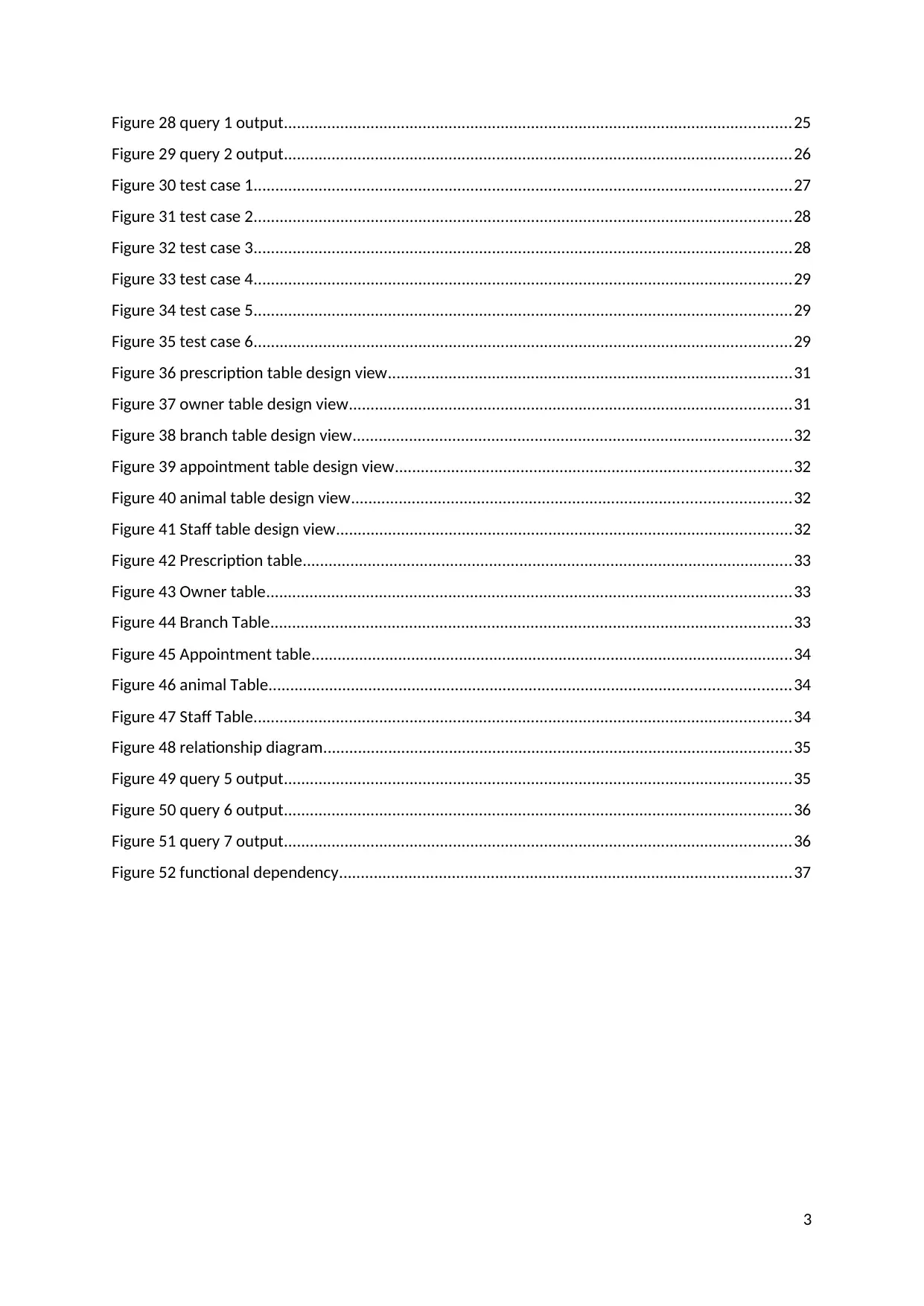
Figure 28 query 1 output.....................................................................................................................25
Figure 29 query 2 output.....................................................................................................................26
Figure 30 test case 1............................................................................................................................27
Figure 31 test case 2............................................................................................................................28
Figure 32 test case 3............................................................................................................................28
Figure 33 test case 4............................................................................................................................29
Figure 34 test case 5............................................................................................................................29
Figure 35 test case 6............................................................................................................................29
Figure 36 prescription table design view.............................................................................................31
Figure 37 owner table design view......................................................................................................31
Figure 38 branch table design view.....................................................................................................32
Figure 39 appointment table design view...........................................................................................32
Figure 40 animal table design view.....................................................................................................32
Figure 41 Staff table design view.........................................................................................................32
Figure 42 Prescription table.................................................................................................................33
Figure 43 Owner table.........................................................................................................................33
Figure 44 Branch Table........................................................................................................................33
Figure 45 Appointment table...............................................................................................................34
Figure 46 animal Table........................................................................................................................34
Figure 47 Staff Table............................................................................................................................34
Figure 48 relationship diagram............................................................................................................35
Figure 49 query 5 output.....................................................................................................................35
Figure 50 query 6 output.....................................................................................................................36
Figure 51 query 7 output.....................................................................................................................36
Figure 52 functional dependency........................................................................................................37
3
Figure 29 query 2 output.....................................................................................................................26
Figure 30 test case 1............................................................................................................................27
Figure 31 test case 2............................................................................................................................28
Figure 32 test case 3............................................................................................................................28
Figure 33 test case 4............................................................................................................................29
Figure 34 test case 5............................................................................................................................29
Figure 35 test case 6............................................................................................................................29
Figure 36 prescription table design view.............................................................................................31
Figure 37 owner table design view......................................................................................................31
Figure 38 branch table design view.....................................................................................................32
Figure 39 appointment table design view...........................................................................................32
Figure 40 animal table design view.....................................................................................................32
Figure 41 Staff table design view.........................................................................................................32
Figure 42 Prescription table.................................................................................................................33
Figure 43 Owner table.........................................................................................................................33
Figure 44 Branch Table........................................................................................................................33
Figure 45 Appointment table...............................................................................................................34
Figure 46 animal Table........................................................................................................................34
Figure 47 Staff Table............................................................................................................................34
Figure 48 relationship diagram............................................................................................................35
Figure 49 query 5 output.....................................................................................................................35
Figure 50 query 6 output.....................................................................................................................36
Figure 51 query 7 output.....................................................................................................................36
Figure 52 functional dependency........................................................................................................37
3
Secure Best Marks with AI Grader
Need help grading? Try our AI Grader for instant feedback on your assignments.

Introduction
Here we will design a database system for the VET solution of Cambridge. It is the veterinary
company that provides services and care for the animals. As the company is growing and has more
information to handle and update they require a much stronger database system for storing
information and altering or updating it on daily basis. The database would also help them to
communicate the information in a much better way. Therefore they asked to build a database for
the same, and it will be done using MS SQL 2014, that gives the best management authority to the
company. In this report, we will design the procedure of database, development and a proper
testing so they can update it on daily basis.
4
Here we will design a database system for the VET solution of Cambridge. It is the veterinary
company that provides services and care for the animals. As the company is growing and has more
information to handle and update they require a much stronger database system for storing
information and altering or updating it on daily basis. The database would also help them to
communicate the information in a much better way. Therefore they asked to build a database for
the same, and it will be done using MS SQL 2014, that gives the best management authority to the
company. In this report, we will design the procedure of database, development and a proper
testing so they can update it on daily basis.
4
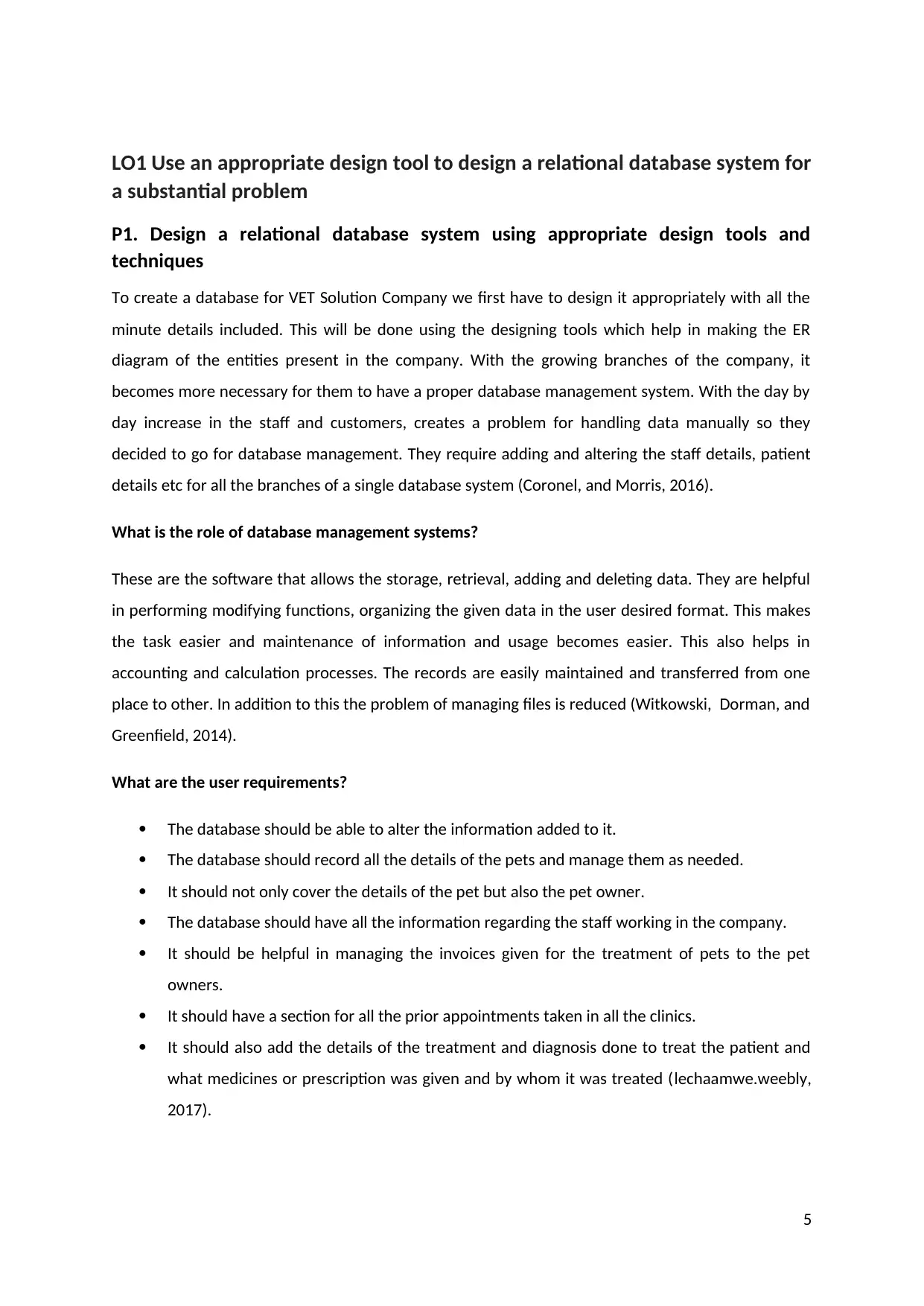
LO1 Use an appropriate design tool to design a relational database system for
a substantial problem
P1. Design a relational database system using appropriate design tools and
techniques
To create a database for VET Solution Company we first have to design it appropriately with all the
minute details included. This will be done using the designing tools which help in making the ER
diagram of the entities present in the company. With the growing branches of the company, it
becomes more necessary for them to have a proper database management system. With the day by
day increase in the staff and customers, creates a problem for handling data manually so they
decided to go for database management. They require adding and altering the staff details, patient
details etc for all the branches of a single database system (Coronel, and Morris, 2016).
What is the role of database management systems?
These are the software that allows the storage, retrieval, adding and deleting data. They are helpful
in performing modifying functions, organizing the given data in the user desired format. This makes
the task easier and maintenance of information and usage becomes easier. This also helps in
accounting and calculation processes. The records are easily maintained and transferred from one
place to other. In addition to this the problem of managing files is reduced (Witkowski, Dorman, and
Greenfield, 2014).
What are the user requirements?
The database should be able to alter the information added to it.
The database should record all the details of the pets and manage them as needed.
It should not only cover the details of the pet but also the pet owner.
The database should have all the information regarding the staff working in the company.
It should be helpful in managing the invoices given for the treatment of pets to the pet
owners.
It should have a section for all the prior appointments taken in all the clinics.
It should also add the details of the treatment and diagnosis done to treat the patient and
what medicines or prescription was given and by whom it was treated (lechaamwe.weebly,
2017).
5
a substantial problem
P1. Design a relational database system using appropriate design tools and
techniques
To create a database for VET Solution Company we first have to design it appropriately with all the
minute details included. This will be done using the designing tools which help in making the ER
diagram of the entities present in the company. With the growing branches of the company, it
becomes more necessary for them to have a proper database management system. With the day by
day increase in the staff and customers, creates a problem for handling data manually so they
decided to go for database management. They require adding and altering the staff details, patient
details etc for all the branches of a single database system (Coronel, and Morris, 2016).
What is the role of database management systems?
These are the software that allows the storage, retrieval, adding and deleting data. They are helpful
in performing modifying functions, organizing the given data in the user desired format. This makes
the task easier and maintenance of information and usage becomes easier. This also helps in
accounting and calculation processes. The records are easily maintained and transferred from one
place to other. In addition to this the problem of managing files is reduced (Witkowski, Dorman, and
Greenfield, 2014).
What are the user requirements?
The database should be able to alter the information added to it.
The database should record all the details of the pets and manage them as needed.
It should not only cover the details of the pet but also the pet owner.
The database should have all the information regarding the staff working in the company.
It should be helpful in managing the invoices given for the treatment of pets to the pet
owners.
It should have a section for all the prior appointments taken in all the clinics.
It should also add the details of the treatment and diagnosis done to treat the patient and
what medicines or prescription was given and by whom it was treated (lechaamwe.weebly,
2017).
5
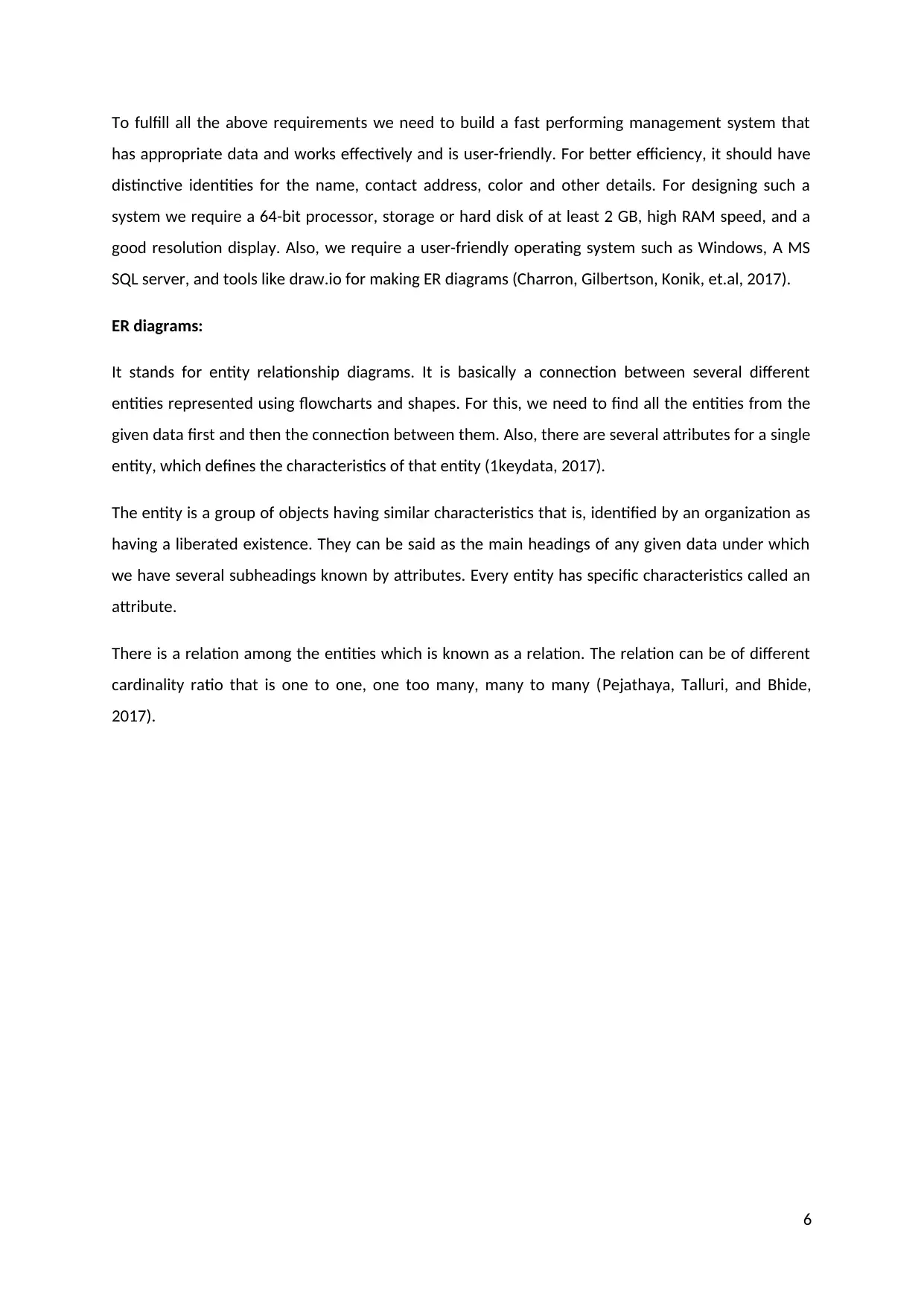
To fulfill all the above requirements we need to build a fast performing management system that
has appropriate data and works effectively and is user-friendly. For better efficiency, it should have
distinctive identities for the name, contact address, color and other details. For designing such a
system we require a 64-bit processor, storage or hard disk of at least 2 GB, high RAM speed, and a
good resolution display. Also, we require a user-friendly operating system such as Windows, A MS
SQL server, and tools like draw.io for making ER diagrams (Charron, Gilbertson, Konik, et.al, 2017).
ER diagrams:
It stands for entity relationship diagrams. It is basically a connection between several different
entities represented using flowcharts and shapes. For this, we need to find all the entities from the
given data first and then the connection between them. Also, there are several attributes for a single
entity, which defines the characteristics of that entity (1keydata, 2017).
The entity is a group of objects having similar characteristics that is, identified by an organization as
having a liberated existence. They can be said as the main headings of any given data under which
we have several subheadings known by attributes. Every entity has specific characteristics called an
attribute.
There is a relation among the entities which is known as a relation. The relation can be of different
cardinality ratio that is one to one, one too many, many to many (Pejathaya, Talluri, and Bhide,
2017).
6
has appropriate data and works effectively and is user-friendly. For better efficiency, it should have
distinctive identities for the name, contact address, color and other details. For designing such a
system we require a 64-bit processor, storage or hard disk of at least 2 GB, high RAM speed, and a
good resolution display. Also, we require a user-friendly operating system such as Windows, A MS
SQL server, and tools like draw.io for making ER diagrams (Charron, Gilbertson, Konik, et.al, 2017).
ER diagrams:
It stands for entity relationship diagrams. It is basically a connection between several different
entities represented using flowcharts and shapes. For this, we need to find all the entities from the
given data first and then the connection between them. Also, there are several attributes for a single
entity, which defines the characteristics of that entity (1keydata, 2017).
The entity is a group of objects having similar characteristics that is, identified by an organization as
having a liberated existence. They can be said as the main headings of any given data under which
we have several subheadings known by attributes. Every entity has specific characteristics called an
attribute.
There is a relation among the entities which is known as a relation. The relation can be of different
cardinality ratio that is one to one, one too many, many to many (Pejathaya, Talluri, and Bhide,
2017).
6
Paraphrase This Document
Need a fresh take? Get an instant paraphrase of this document with our AI Paraphraser
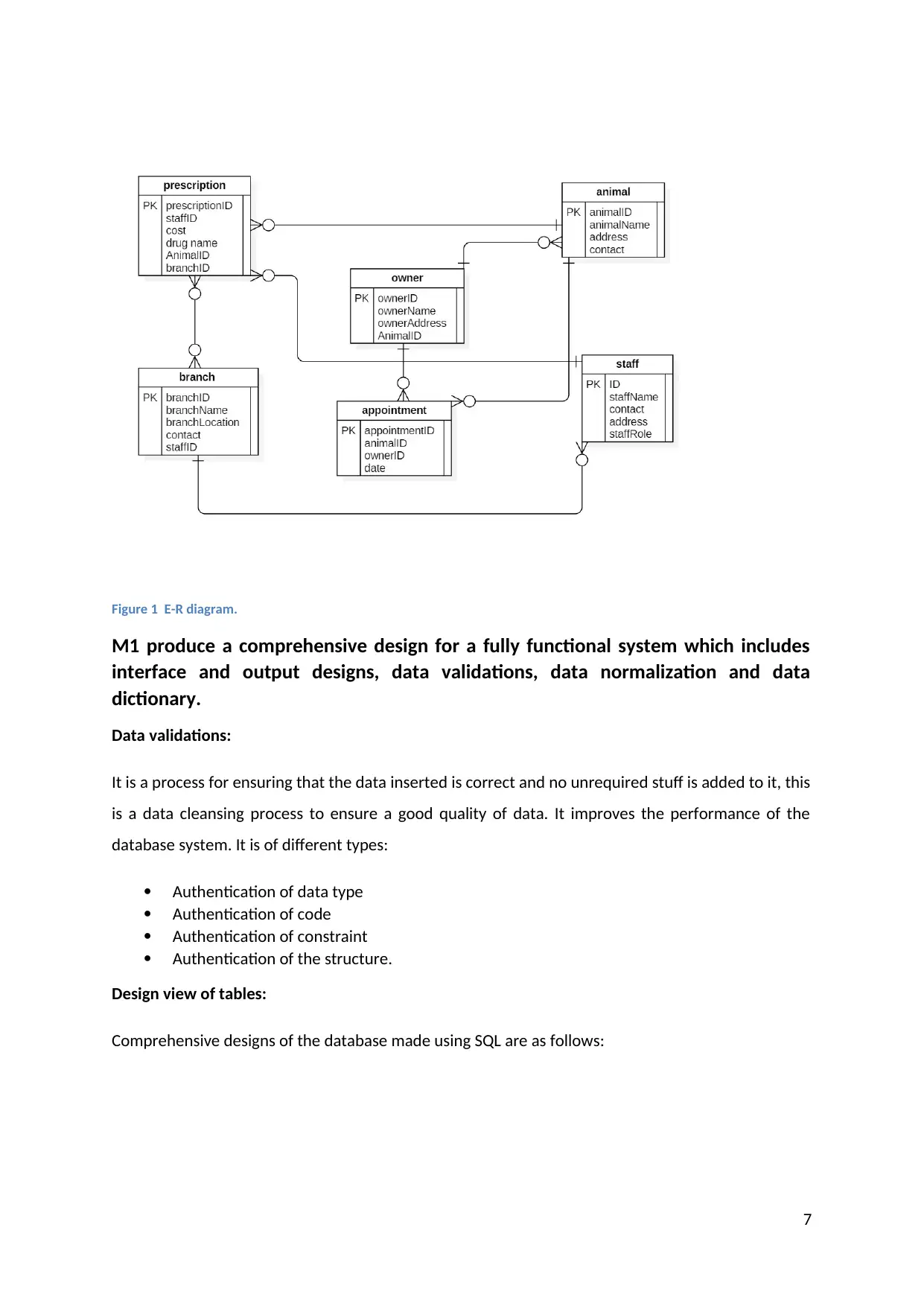
Figure 1 E-R diagram.
M1 produce a comprehensive design for a fully functional system which includes
interface and output designs, data validations, data normalization and data
dictionary.
Data validations:
It is a process for ensuring that the data inserted is correct and no unrequired stuff is added to it, this
is a data cleansing process to ensure a good quality of data. It improves the performance of the
database system. It is of different types:
Authentication of data type
Authentication of code
Authentication of constraint
Authentication of the structure.
Design view of tables:
Comprehensive designs of the database made using SQL are as follows:
7
M1 produce a comprehensive design for a fully functional system which includes
interface and output designs, data validations, data normalization and data
dictionary.
Data validations:
It is a process for ensuring that the data inserted is correct and no unrequired stuff is added to it, this
is a data cleansing process to ensure a good quality of data. It improves the performance of the
database system. It is of different types:
Authentication of data type
Authentication of code
Authentication of constraint
Authentication of the structure.
Design view of tables:
Comprehensive designs of the database made using SQL are as follows:
7
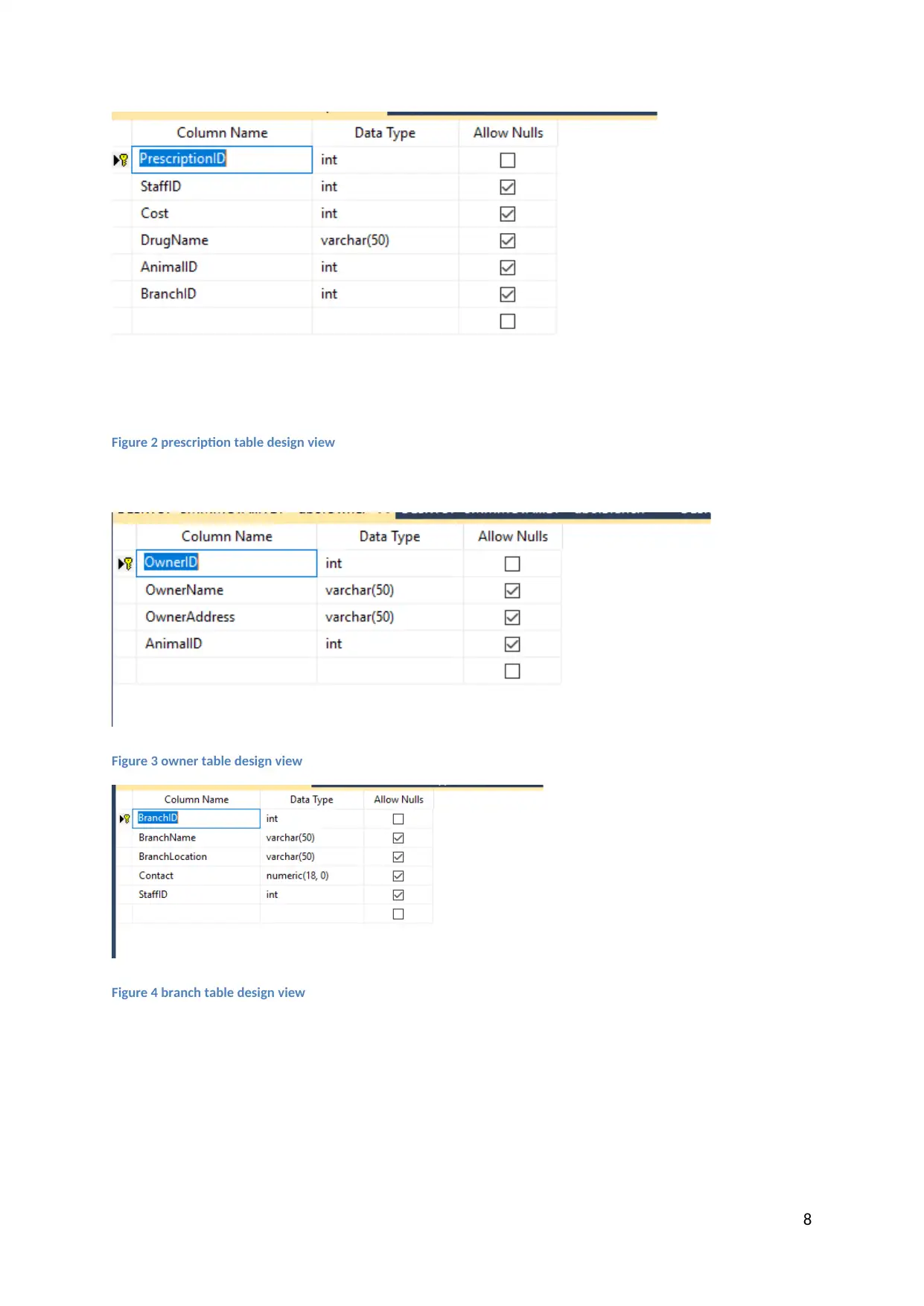
Figure 2 prescription table design view
Figure 3 owner table design view
Figure 4 branch table design view
8
Figure 3 owner table design view
Figure 4 branch table design view
8
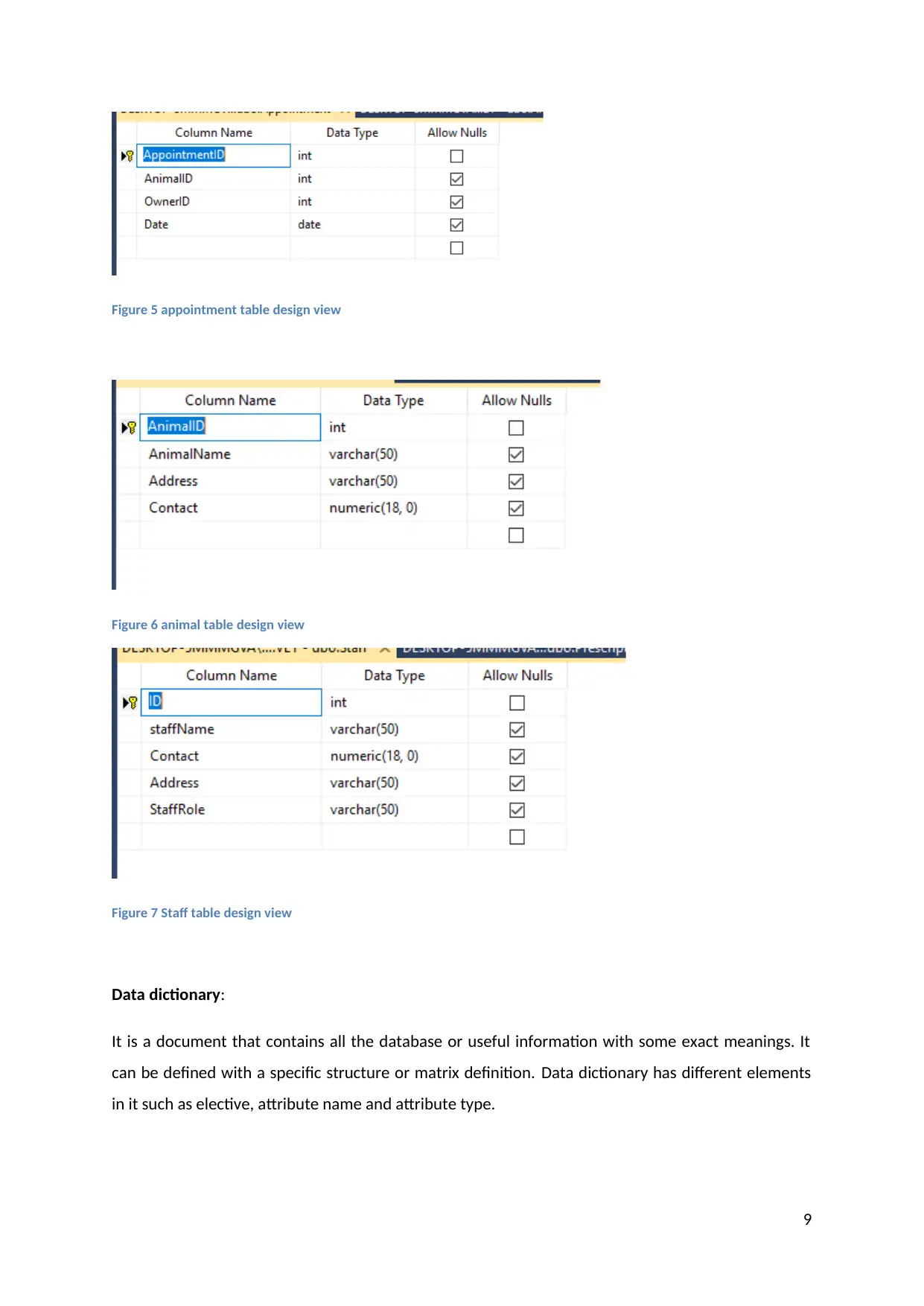
Figure 5 appointment table design view
Figure 6 animal table design view
Figure 7 Staff table design view
Data dictionary:
It is a document that contains all the database or useful information with some exact meanings. It
can be defined with a specific structure or matrix definition. Data dictionary has different elements
in it such as elective, attribute name and attribute type.
9
Figure 6 animal table design view
Figure 7 Staff table design view
Data dictionary:
It is a document that contains all the database or useful information with some exact meanings. It
can be defined with a specific structure or matrix definition. Data dictionary has different elements
in it such as elective, attribute name and attribute type.
9
Secure Best Marks with AI Grader
Need help grading? Try our AI Grader for instant feedback on your assignments.
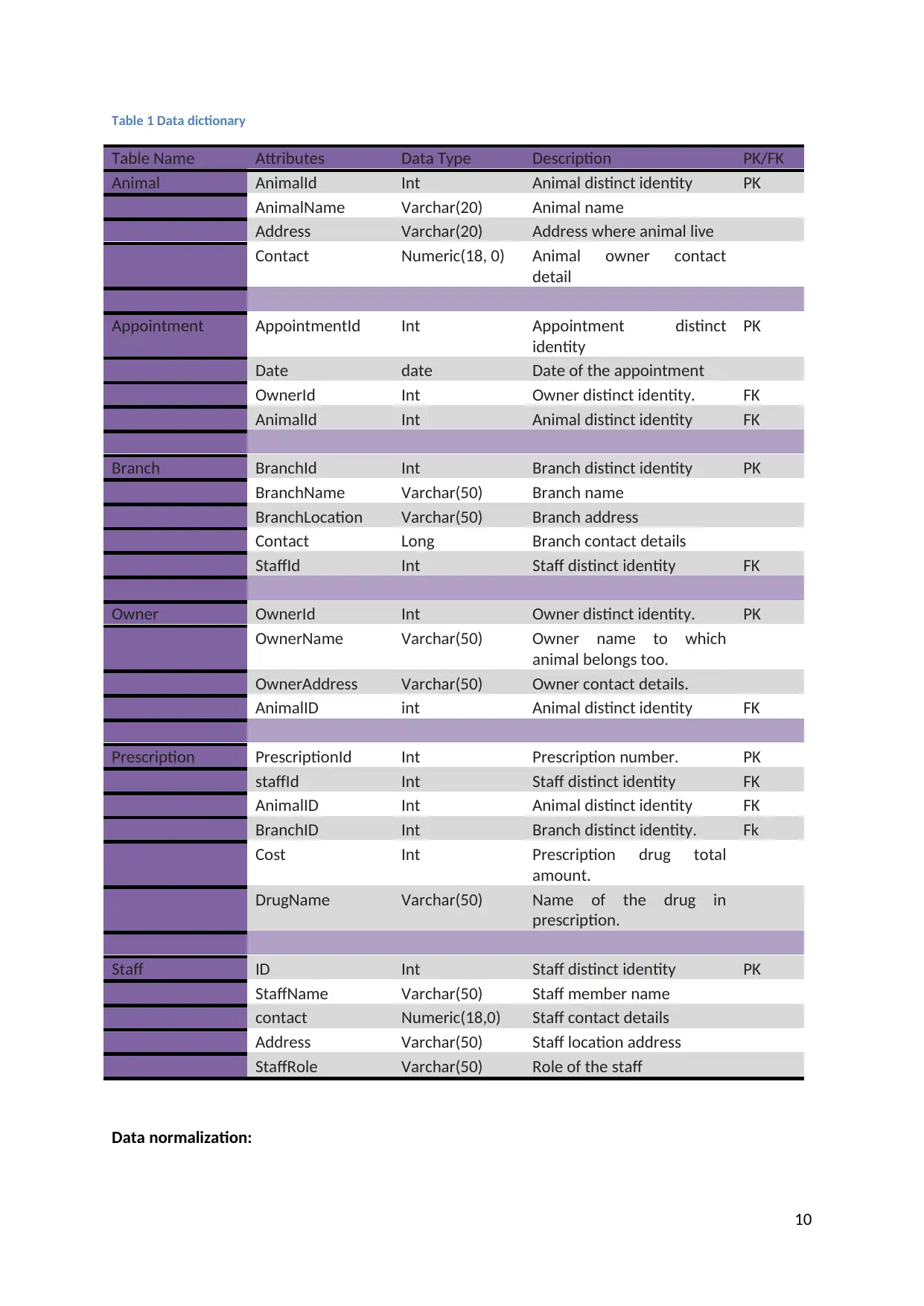
Table 1 Data dictionary
Table Name Attributes Data Type Description PK/FK
Animal AnimalId Int Animal distinct identity PK
AnimalName Varchar(20) Animal name
Address Varchar(20) Address where animal live
Contact Numeric(18, 0) Animal owner contact
detail
Appointment AppointmentId Int Appointment distinct
identity
PK
Date date Date of the appointment
OwnerId Int Owner distinct identity. FK
AnimalId Int Animal distinct identity FK
Branch BranchId Int Branch distinct identity PK
BranchName Varchar(50) Branch name
BranchLocation Varchar(50) Branch address
Contact Long Branch contact details
StaffId Int Staff distinct identity FK
Owner OwnerId Int Owner distinct identity. PK
OwnerName Varchar(50) Owner name to which
animal belongs too.
OwnerAddress Varchar(50) Owner contact details.
AnimalID int Animal distinct identity FK
Prescription PrescriptionId Int Prescription number. PK
staffId Int Staff distinct identity FK
AnimalID Int Animal distinct identity FK
BranchID Int Branch distinct identity. Fk
Cost Int Prescription drug total
amount.
DrugName Varchar(50) Name of the drug in
prescription.
Staff ID Int Staff distinct identity PK
StaffName Varchar(50) Staff member name
contact Numeric(18,0) Staff contact details
Address Varchar(50) Staff location address
StaffRole Varchar(50) Role of the staff
Data normalization:
10
Table Name Attributes Data Type Description PK/FK
Animal AnimalId Int Animal distinct identity PK
AnimalName Varchar(20) Animal name
Address Varchar(20) Address where animal live
Contact Numeric(18, 0) Animal owner contact
detail
Appointment AppointmentId Int Appointment distinct
identity
PK
Date date Date of the appointment
OwnerId Int Owner distinct identity. FK
AnimalId Int Animal distinct identity FK
Branch BranchId Int Branch distinct identity PK
BranchName Varchar(50) Branch name
BranchLocation Varchar(50) Branch address
Contact Long Branch contact details
StaffId Int Staff distinct identity FK
Owner OwnerId Int Owner distinct identity. PK
OwnerName Varchar(50) Owner name to which
animal belongs too.
OwnerAddress Varchar(50) Owner contact details.
AnimalID int Animal distinct identity FK
Prescription PrescriptionId Int Prescription number. PK
staffId Int Staff distinct identity FK
AnimalID Int Animal distinct identity FK
BranchID Int Branch distinct identity. Fk
Cost Int Prescription drug total
amount.
DrugName Varchar(50) Name of the drug in
prescription.
Staff ID Int Staff distinct identity PK
StaffName Varchar(50) Staff member name
contact Numeric(18,0) Staff contact details
Address Varchar(50) Staff location address
StaffRole Varchar(50) Role of the staff
Data normalization:
10
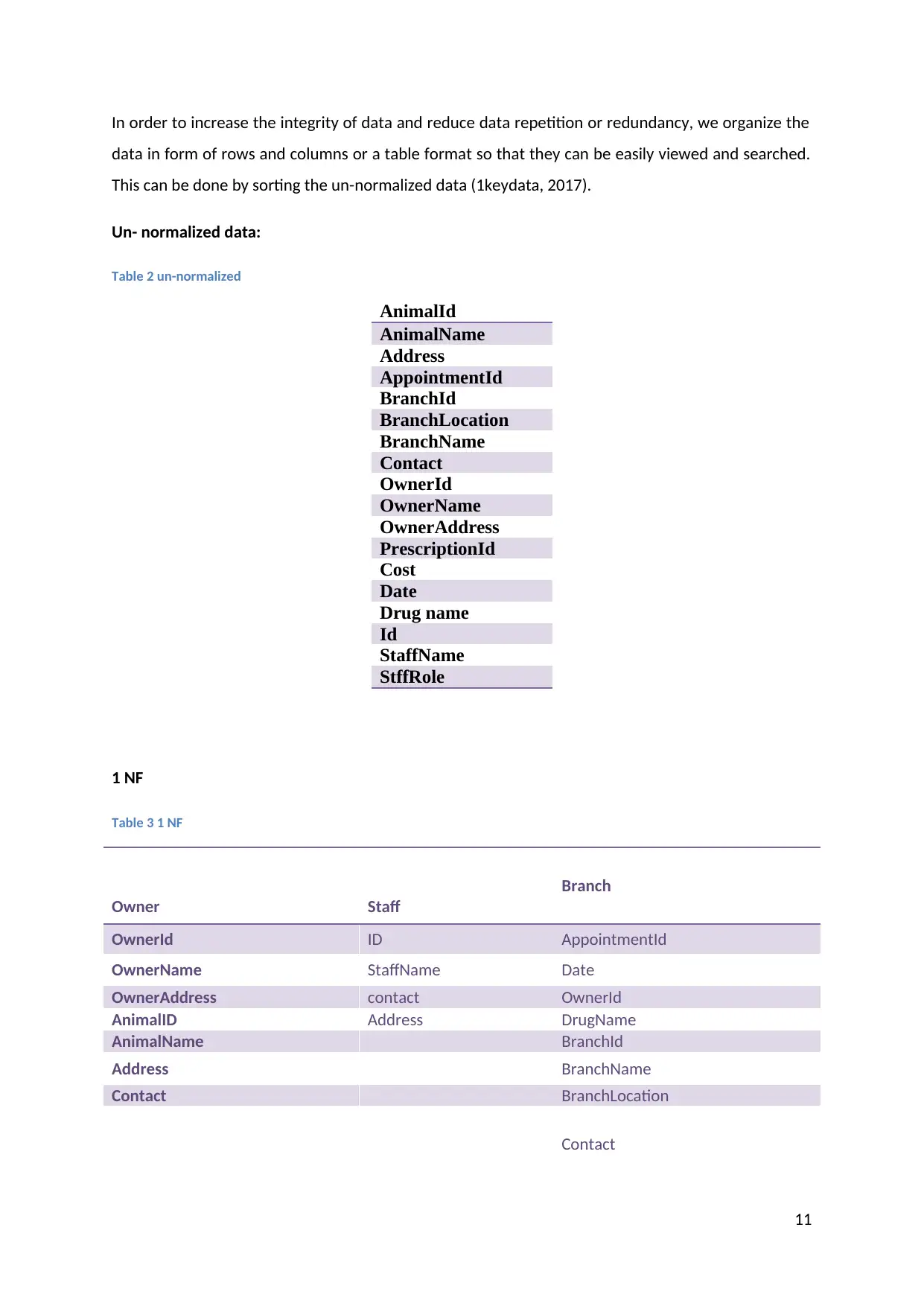
In order to increase the integrity of data and reduce data repetition or redundancy, we organize the
data in form of rows and columns or a table format so that they can be easily viewed and searched.
This can be done by sorting the un-normalized data (1keydata, 2017).
Un- normalized data:
Table 2 un-normalized
AnimalId
AnimalName
Address
AppointmentId
BranchId
BranchLocation
BranchName
Contact
OwnerId
OwnerName
OwnerAddress
PrescriptionId
Cost
Date
Drug name
Id
StaffName
StffRole
1 NF
Table 3 1 NF
Owner Staff
Branch
OwnerId ID AppointmentId
OwnerName StaffName Date
OwnerAddress contact OwnerId
AnimalID Address DrugName
AnimalName BranchId
Address BranchName
Contact BranchLocation
Contact
11
data in form of rows and columns or a table format so that they can be easily viewed and searched.
This can be done by sorting the un-normalized data (1keydata, 2017).
Un- normalized data:
Table 2 un-normalized
AnimalId
AnimalName
Address
AppointmentId
BranchId
BranchLocation
BranchName
Contact
OwnerId
OwnerName
OwnerAddress
PrescriptionId
Cost
Date
Drug name
Id
StaffName
StffRole
1 NF
Table 3 1 NF
Owner Staff
Branch
OwnerId ID AppointmentId
OwnerName StaffName Date
OwnerAddress contact OwnerId
AnimalID Address DrugName
AnimalName BranchId
Address BranchName
Contact BranchLocation
Contact
11

StaffId
PrescriptionId
staffId
AnimalID
BranchID
Cost
2 NF
Table 4 2 NF
Owner Staff
Branch Prescription
OwnerId ID AppointmentId PrescriptionId
AnimalID StaffName Date staffId
OwnerId contact OwnerId AnimalID
OwnerName Address AnimalId BranchID
OwnerAddress StaffRole BranchId Cost
AnimalId BranchName DrugName
AnimalName BranchLocation
Address contact
Contact
3 NF
12
PrescriptionId
staffId
AnimalID
BranchID
Cost
2 NF
Table 4 2 NF
Owner Staff
Branch Prescription
OwnerId ID AppointmentId PrescriptionId
AnimalID StaffName Date staffId
OwnerId contact OwnerId AnimalID
OwnerName Address AnimalId BranchID
OwnerAddress StaffRole BranchId Cost
AnimalId BranchName DrugName
AnimalName BranchLocation
Address contact
Contact
3 NF
12
Paraphrase This Document
Need a fresh take? Get an instant paraphrase of this document with our AI Paraphraser
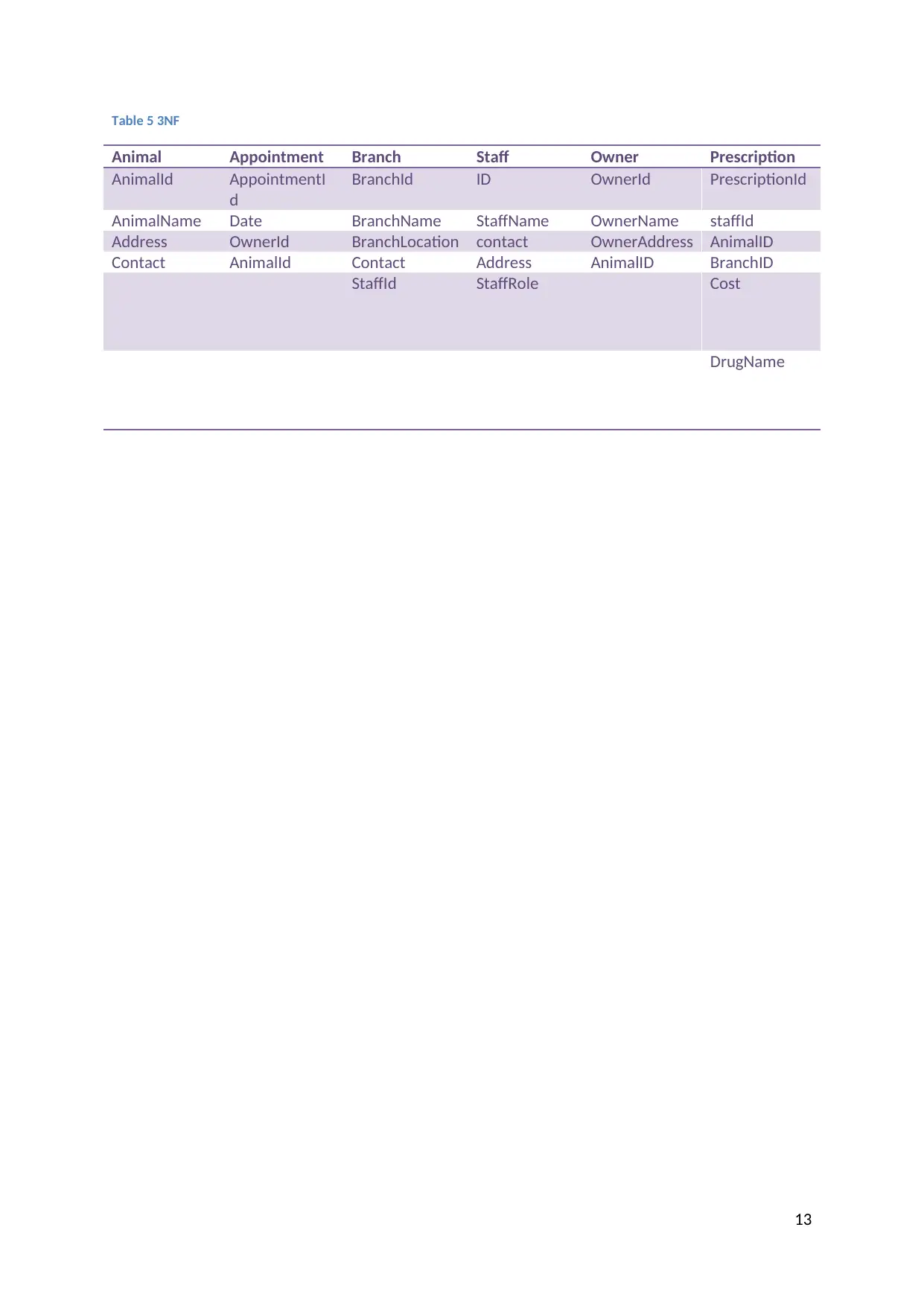
Table 5 3NF
Animal Appointment Branch Staff Owner Prescription
AnimalId AppointmentI
d
BranchId ID OwnerId PrescriptionId
AnimalName Date BranchName StaffName OwnerName staffId
Address OwnerId BranchLocation contact OwnerAddress AnimalID
Contact AnimalId Contact Address AnimalID BranchID
StaffId StaffRole Cost
DrugName
13
Animal Appointment Branch Staff Owner Prescription
AnimalId AppointmentI
d
BranchId ID OwnerId PrescriptionId
AnimalName Date BranchName StaffName OwnerName staffId
Address OwnerId BranchLocation contact OwnerAddress AnimalID
Contact AnimalId Contact Address AnimalID BranchID
StaffId StaffRole Cost
DrugName
13
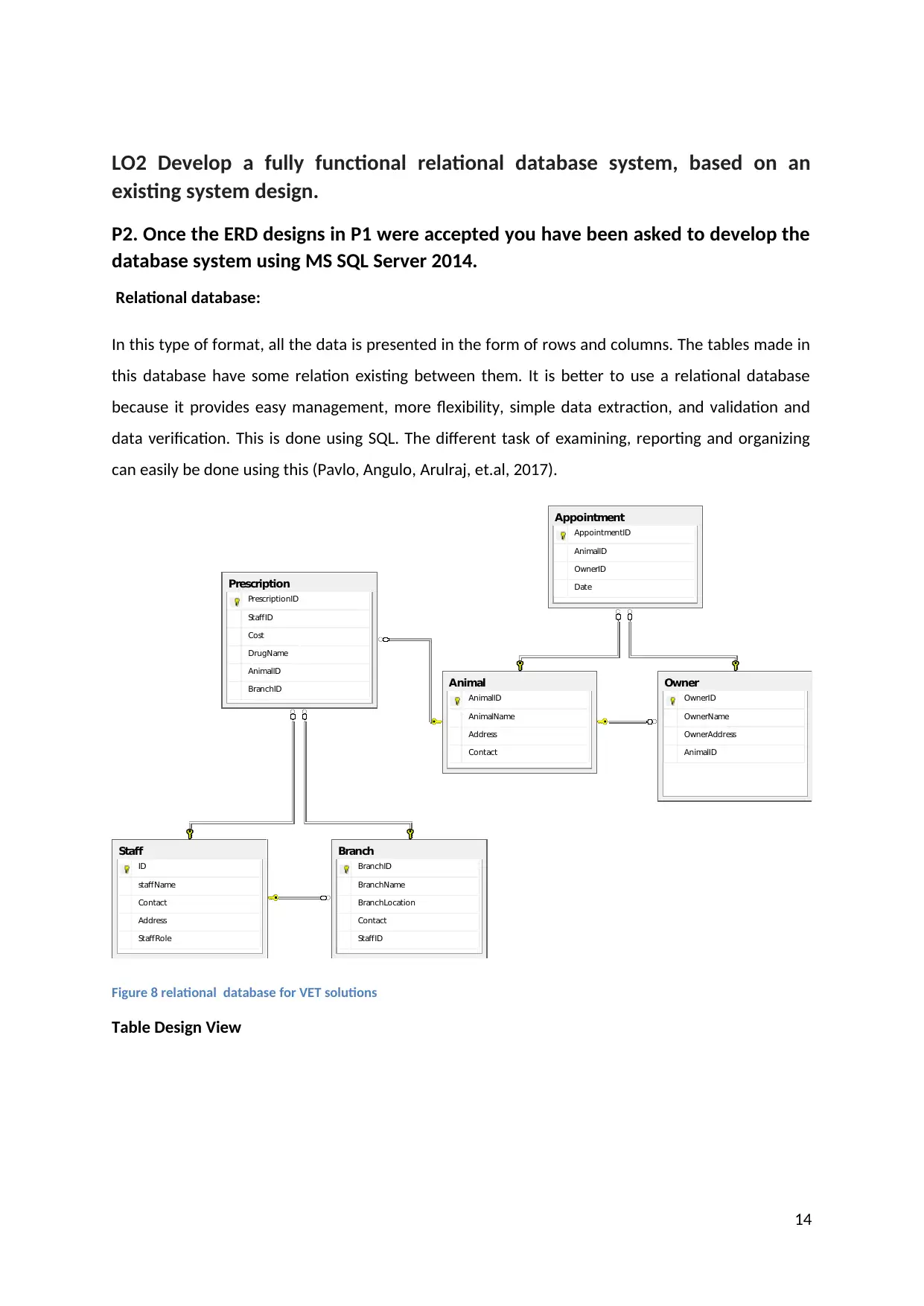
LO2 Develop a fully functional relational database system, based on an
existing system design.
P2. Once the ERD designs in P1 were accepted you have been asked to develop the
database system using MS SQL Server 2014.
Relational database:
In this type of format, all the data is presented in the form of rows and columns. The tables made in
this database have some relation existing between them. It is better to use a relational database
because it provides easy management, more flexibility, simple data extraction, and validation and
data verification. This is done using SQL. The different task of examining, reporting and organizing
can easily be done using this (Pavlo, Angulo, Arulraj, et.al, 2017).
Animal
AnimalID
AnimalName
Address
Contact
Appointment
AppointmentID
AnimalID
OwnerID
Date
Branch
BranchID
BranchName
BranchLocation
Contact
StaffID
Owner
OwnerID
OwnerName
OwnerAddress
AnimalID
Prescription
PrescriptionID
StaffID
Cost
DrugName
AnimalID
BranchID
Staff
ID
staffName
Contact
Address
StaffRole
Figure 8 relational database for VET solutions
Table Design View
14
existing system design.
P2. Once the ERD designs in P1 were accepted you have been asked to develop the
database system using MS SQL Server 2014.
Relational database:
In this type of format, all the data is presented in the form of rows and columns. The tables made in
this database have some relation existing between them. It is better to use a relational database
because it provides easy management, more flexibility, simple data extraction, and validation and
data verification. This is done using SQL. The different task of examining, reporting and organizing
can easily be done using this (Pavlo, Angulo, Arulraj, et.al, 2017).
Animal
AnimalID
AnimalName
Address
Contact
Appointment
AppointmentID
AnimalID
OwnerID
Date
Branch
BranchID
BranchName
BranchLocation
Contact
StaffID
Owner
OwnerID
OwnerName
OwnerAddress
AnimalID
Prescription
PrescriptionID
StaffID
Cost
DrugName
AnimalID
BranchID
Staff
ID
staffName
Contact
Address
StaffRole
Figure 8 relational database for VET solutions
Table Design View
14
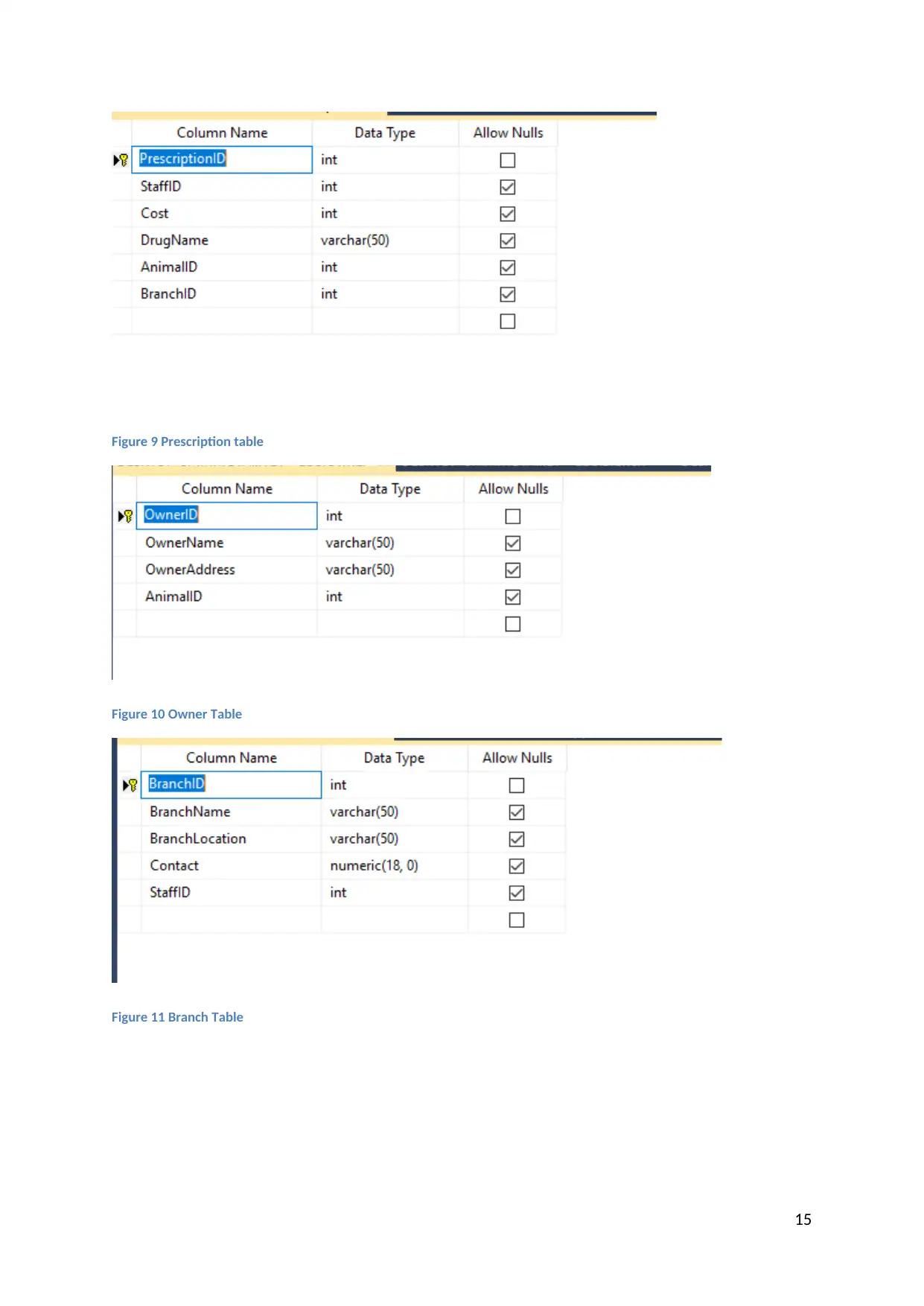
Figure 9 Prescription table
Figure 10 Owner Table
Figure 11 Branch Table
15
Figure 10 Owner Table
Figure 11 Branch Table
15
Secure Best Marks with AI Grader
Need help grading? Try our AI Grader for instant feedback on your assignments.
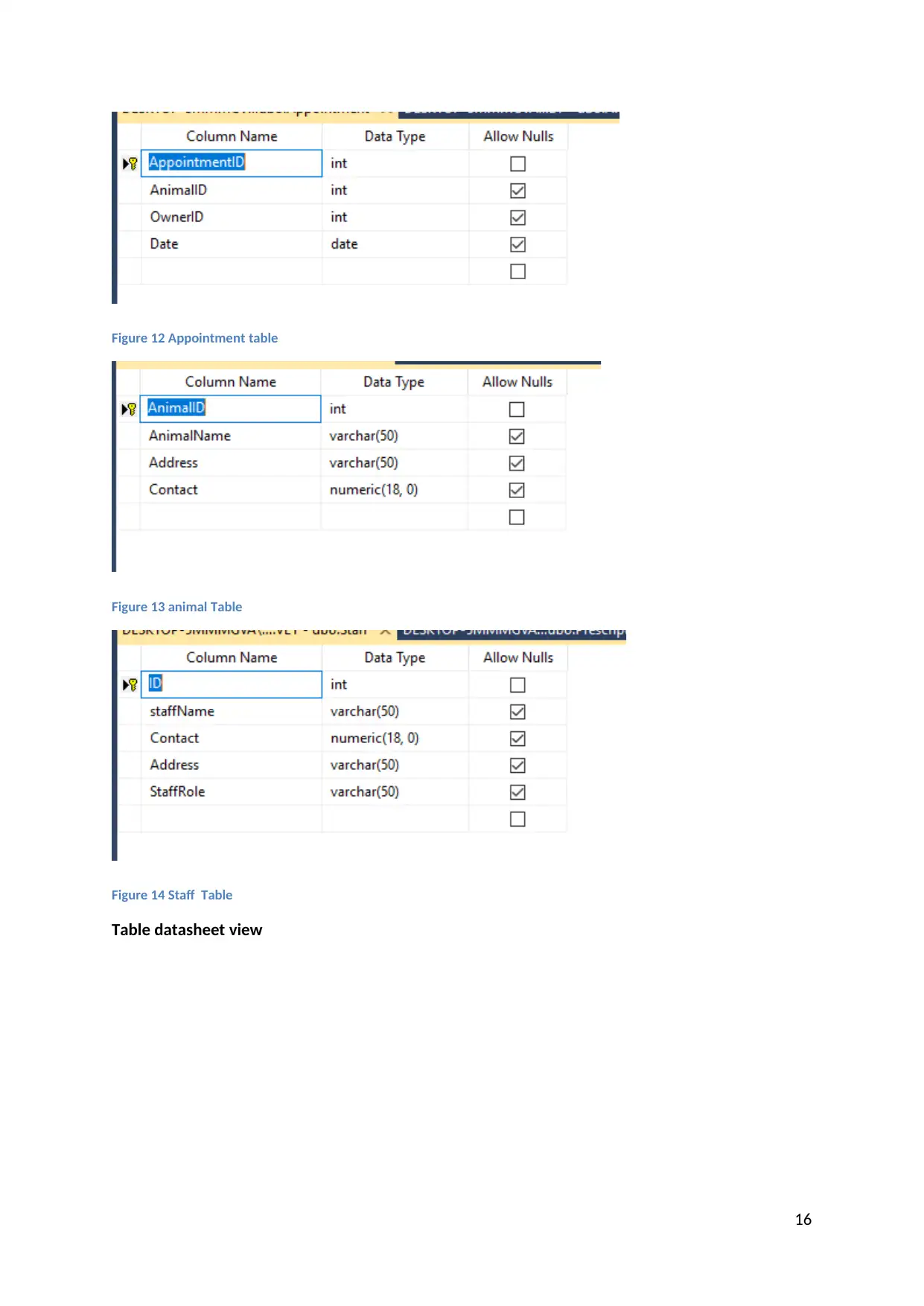
Figure 12 Appointment table
Figure 13 animal Table
Figure 14 Staff Table
Table datasheet view
16
Figure 13 animal Table
Figure 14 Staff Table
Table datasheet view
16
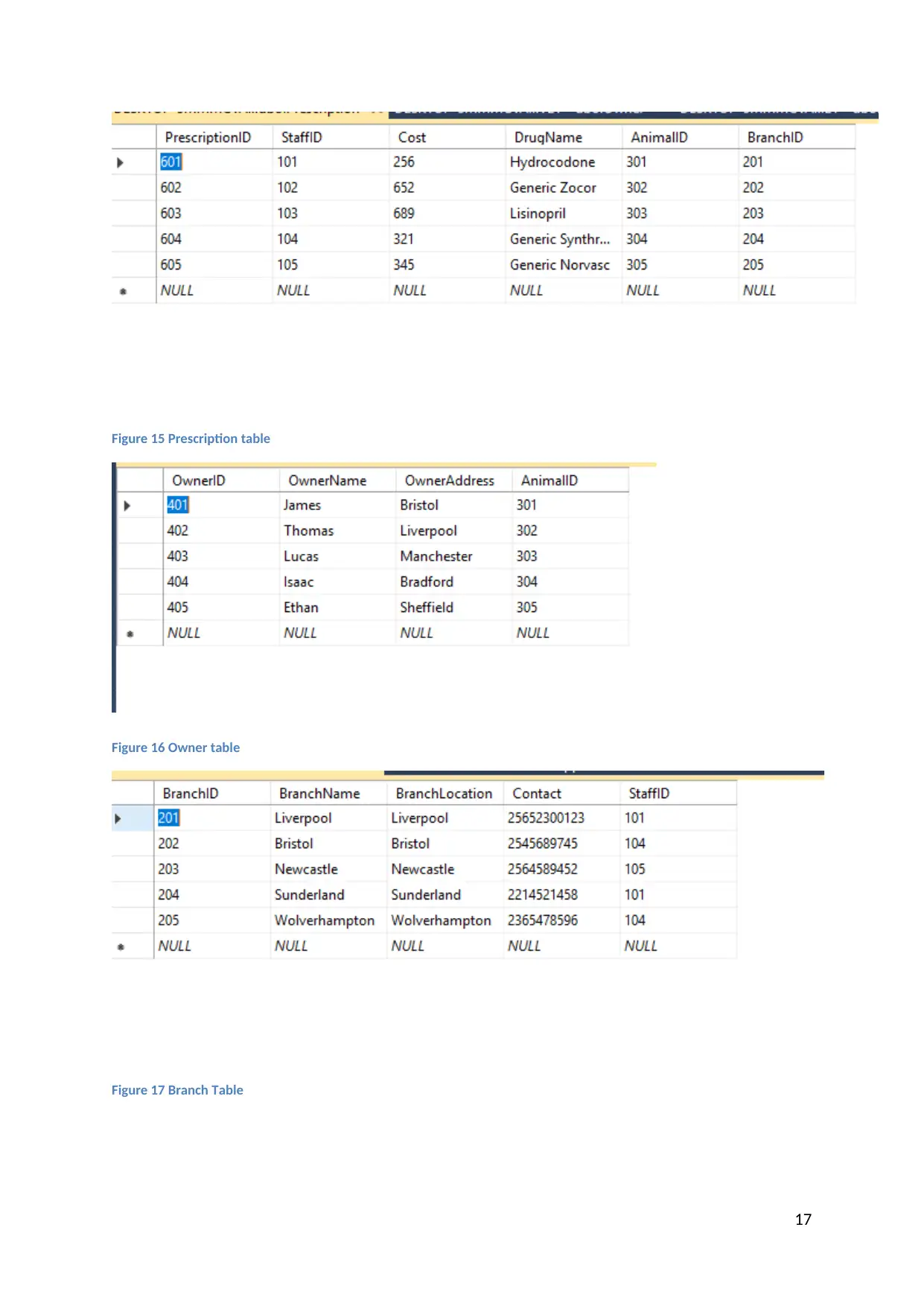
Figure 15 Prescription table
Figure 16 Owner table
Figure 17 Branch Table
17
Figure 16 Owner table
Figure 17 Branch Table
17
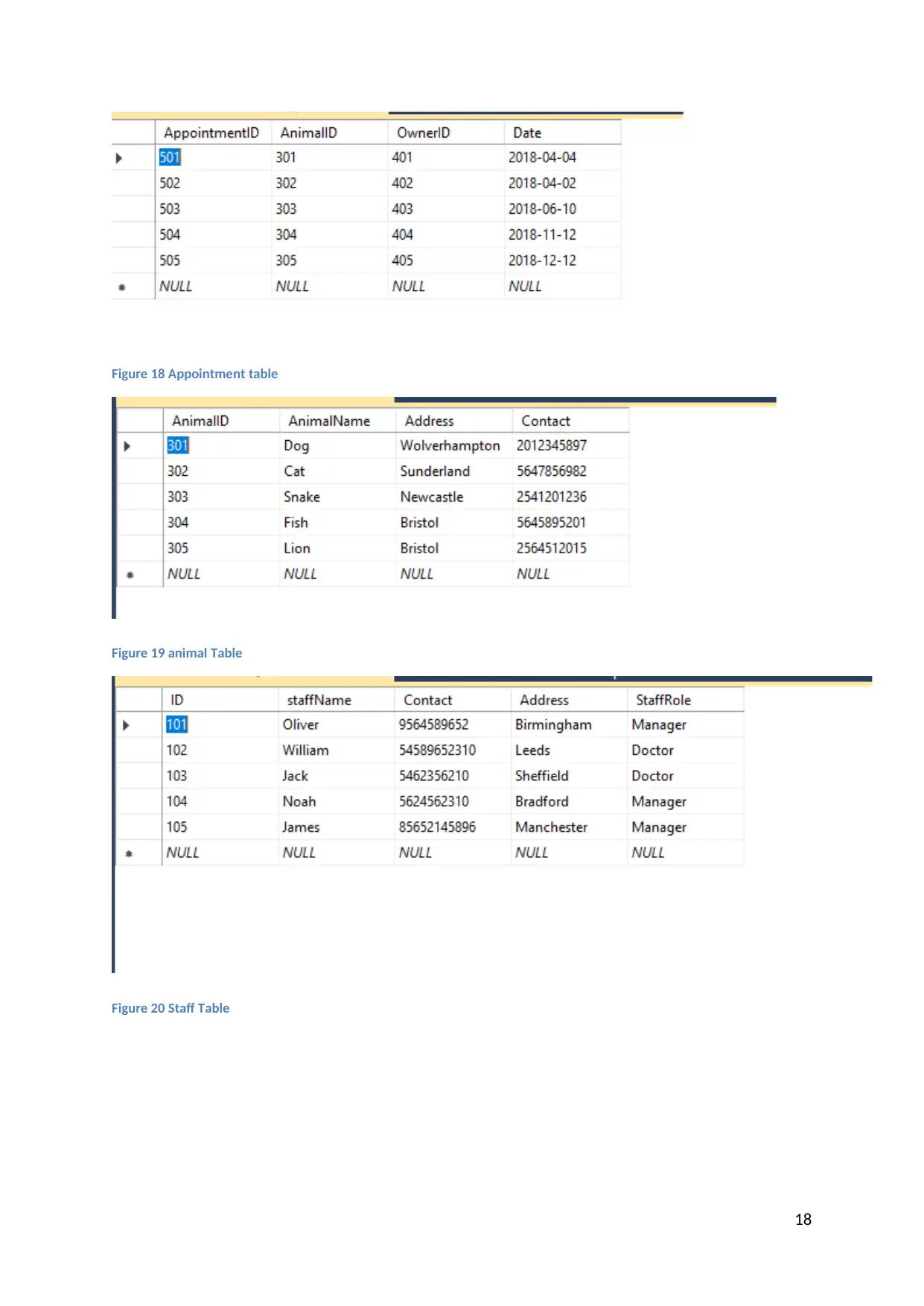
Figure 18 Appointment table
Figure 19 animal Table
Figure 20 Staff Table
18
Figure 19 animal Table
Figure 20 Staff Table
18
Paraphrase This Document
Need a fresh take? Get an instant paraphrase of this document with our AI Paraphraser
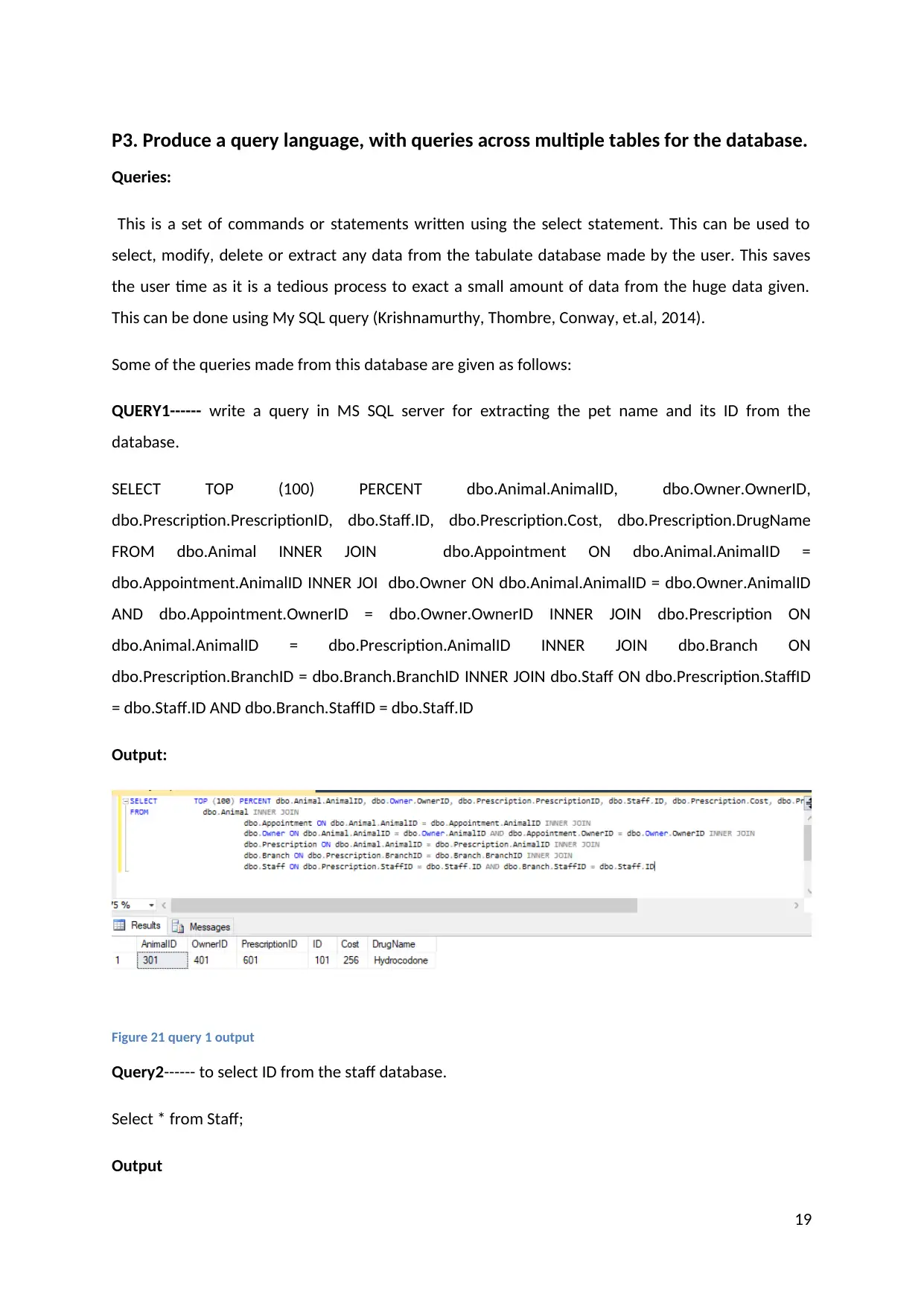
P3. Produce a query language, with queries across multiple tables for the database.
Queries:
This is a set of commands or statements written using the select statement. This can be used to
select, modify, delete or extract any data from the tabulate database made by the user. This saves
the user time as it is a tedious process to exact a small amount of data from the huge data given.
This can be done using My SQL query (Krishnamurthy, Thombre, Conway, et.al, 2014).
Some of the queries made from this database are given as follows:
QUERY1------ write a query in MS SQL server for extracting the pet name and its ID from the
database.
SELECT TOP (100) PERCENT dbo.Animal.AnimalID, dbo.Owner.OwnerID,
dbo.Prescription.PrescriptionID, dbo.Staff.ID, dbo.Prescription.Cost, dbo.Prescription.DrugName
FROM dbo.Animal INNER JOIN dbo.Appointment ON dbo.Animal.AnimalID =
dbo.Appointment.AnimalID INNER JOI dbo.Owner ON dbo.Animal.AnimalID = dbo.Owner.AnimalID
AND dbo.Appointment.OwnerID = dbo.Owner.OwnerID INNER JOIN dbo.Prescription ON
dbo.Animal.AnimalID = dbo.Prescription.AnimalID INNER JOIN dbo.Branch ON
dbo.Prescription.BranchID = dbo.Branch.BranchID INNER JOIN dbo.Staff ON dbo.Prescription.StaffID
= dbo.Staff.ID AND dbo.Branch.StaffID = dbo.Staff.ID
Output:
Figure 21 query 1 output
Query2------ to select ID from the staff database.
Select * from Staff;
Output
19
Queries:
This is a set of commands or statements written using the select statement. This can be used to
select, modify, delete or extract any data from the tabulate database made by the user. This saves
the user time as it is a tedious process to exact a small amount of data from the huge data given.
This can be done using My SQL query (Krishnamurthy, Thombre, Conway, et.al, 2014).
Some of the queries made from this database are given as follows:
QUERY1------ write a query in MS SQL server for extracting the pet name and its ID from the
database.
SELECT TOP (100) PERCENT dbo.Animal.AnimalID, dbo.Owner.OwnerID,
dbo.Prescription.PrescriptionID, dbo.Staff.ID, dbo.Prescription.Cost, dbo.Prescription.DrugName
FROM dbo.Animal INNER JOIN dbo.Appointment ON dbo.Animal.AnimalID =
dbo.Appointment.AnimalID INNER JOI dbo.Owner ON dbo.Animal.AnimalID = dbo.Owner.AnimalID
AND dbo.Appointment.OwnerID = dbo.Owner.OwnerID INNER JOIN dbo.Prescription ON
dbo.Animal.AnimalID = dbo.Prescription.AnimalID INNER JOIN dbo.Branch ON
dbo.Prescription.BranchID = dbo.Branch.BranchID INNER JOIN dbo.Staff ON dbo.Prescription.StaffID
= dbo.Staff.ID AND dbo.Branch.StaffID = dbo.Staff.ID
Output:
Figure 21 query 1 output
Query2------ to select ID from the staff database.
Select * from Staff;
Output
19
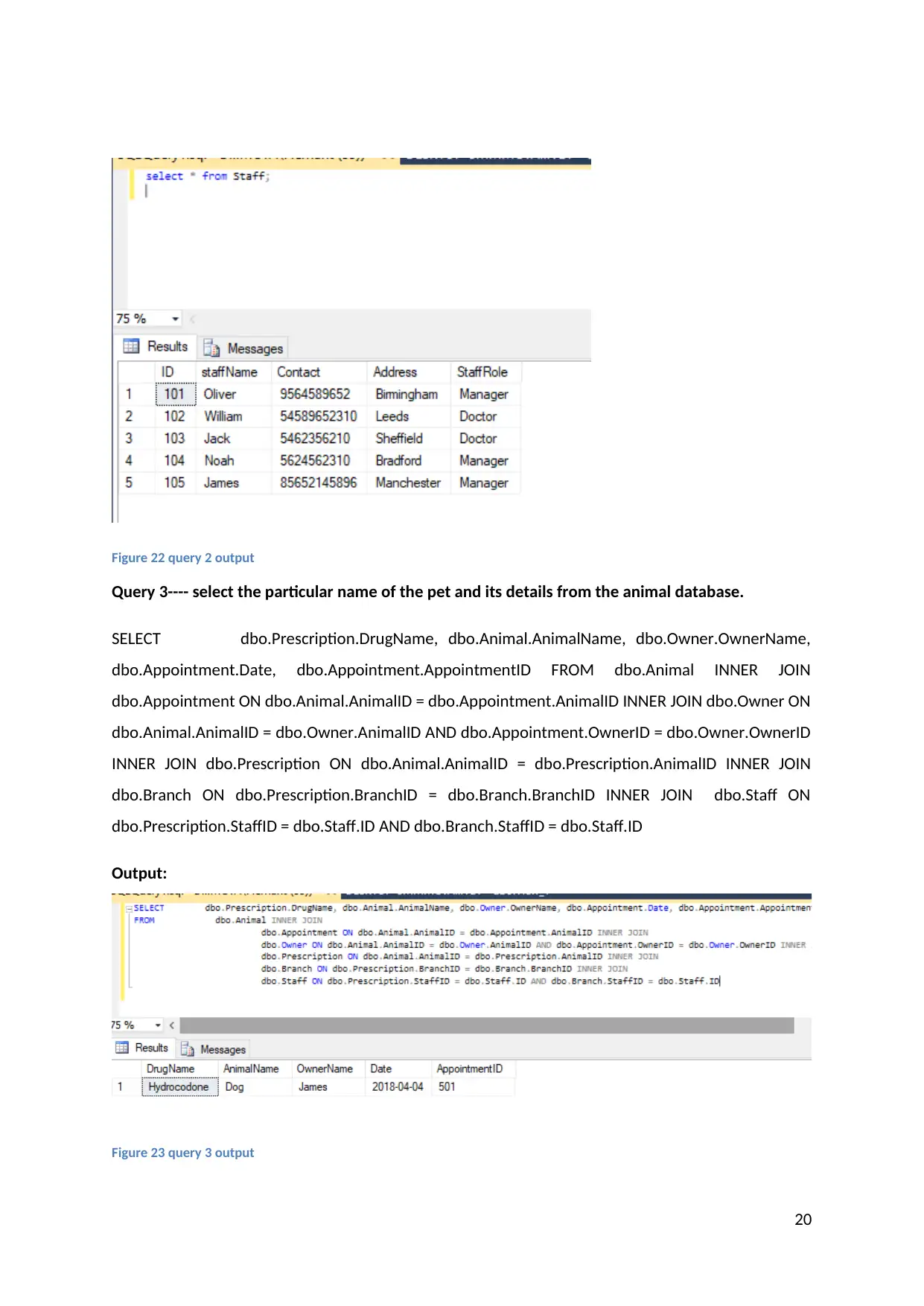
Figure 22 query 2 output
Query 3---- select the particular name of the pet and its details from the animal database.
SELECT dbo.Prescription.DrugName, dbo.Animal.AnimalName, dbo.Owner.OwnerName,
dbo.Appointment.Date, dbo.Appointment.AppointmentID FROM dbo.Animal INNER JOIN
dbo.Appointment ON dbo.Animal.AnimalID = dbo.Appointment.AnimalID INNER JOIN dbo.Owner ON
dbo.Animal.AnimalID = dbo.Owner.AnimalID AND dbo.Appointment.OwnerID = dbo.Owner.OwnerID
INNER JOIN dbo.Prescription ON dbo.Animal.AnimalID = dbo.Prescription.AnimalID INNER JOIN
dbo.Branch ON dbo.Prescription.BranchID = dbo.Branch.BranchID INNER JOIN dbo.Staff ON
dbo.Prescription.StaffID = dbo.Staff.ID AND dbo.Branch.StaffID = dbo.Staff.ID
Output:
Figure 23 query 3 output
20
Query 3---- select the particular name of the pet and its details from the animal database.
SELECT dbo.Prescription.DrugName, dbo.Animal.AnimalName, dbo.Owner.OwnerName,
dbo.Appointment.Date, dbo.Appointment.AppointmentID FROM dbo.Animal INNER JOIN
dbo.Appointment ON dbo.Animal.AnimalID = dbo.Appointment.AnimalID INNER JOIN dbo.Owner ON
dbo.Animal.AnimalID = dbo.Owner.AnimalID AND dbo.Appointment.OwnerID = dbo.Owner.OwnerID
INNER JOIN dbo.Prescription ON dbo.Animal.AnimalID = dbo.Prescription.AnimalID INNER JOIN
dbo.Branch ON dbo.Prescription.BranchID = dbo.Branch.BranchID INNER JOIN dbo.Staff ON
dbo.Prescription.StaffID = dbo.Staff.ID AND dbo.Branch.StaffID = dbo.Staff.ID
Output:
Figure 23 query 3 output
20
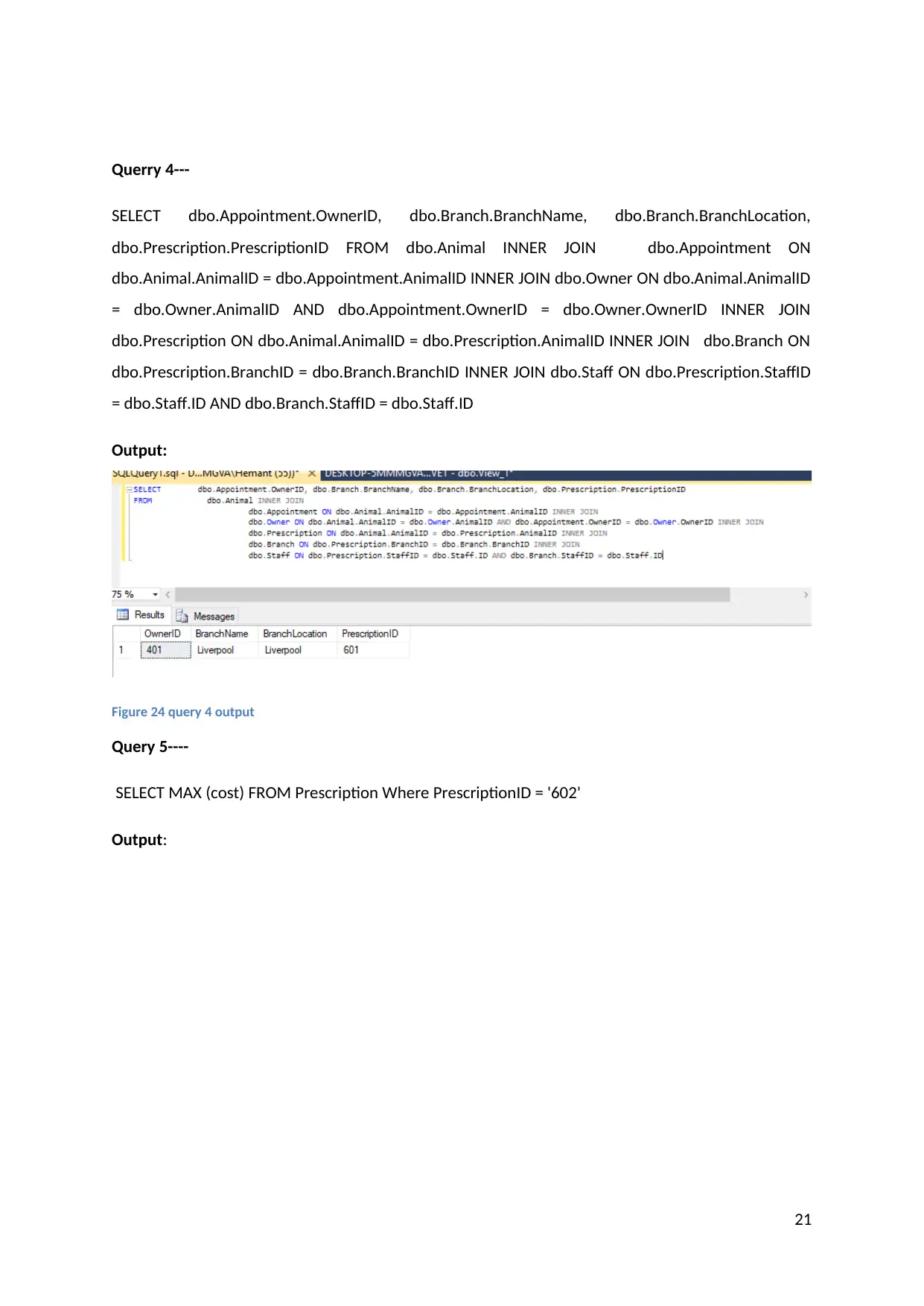
Querry 4---
SELECT dbo.Appointment.OwnerID, dbo.Branch.BranchName, dbo.Branch.BranchLocation,
dbo.Prescription.PrescriptionID FROM dbo.Animal INNER JOIN dbo.Appointment ON
dbo.Animal.AnimalID = dbo.Appointment.AnimalID INNER JOIN dbo.Owner ON dbo.Animal.AnimalID
= dbo.Owner.AnimalID AND dbo.Appointment.OwnerID = dbo.Owner.OwnerID INNER JOIN
dbo.Prescription ON dbo.Animal.AnimalID = dbo.Prescription.AnimalID INNER JOIN dbo.Branch ON
dbo.Prescription.BranchID = dbo.Branch.BranchID INNER JOIN dbo.Staff ON dbo.Prescription.StaffID
= dbo.Staff.ID AND dbo.Branch.StaffID = dbo.Staff.ID
Output:
Figure 24 query 4 output
Query 5----
SELECT MAX (cost) FROM Prescription Where PrescriptionID = '602'
Output:
21
SELECT dbo.Appointment.OwnerID, dbo.Branch.BranchName, dbo.Branch.BranchLocation,
dbo.Prescription.PrescriptionID FROM dbo.Animal INNER JOIN dbo.Appointment ON
dbo.Animal.AnimalID = dbo.Appointment.AnimalID INNER JOIN dbo.Owner ON dbo.Animal.AnimalID
= dbo.Owner.AnimalID AND dbo.Appointment.OwnerID = dbo.Owner.OwnerID INNER JOIN
dbo.Prescription ON dbo.Animal.AnimalID = dbo.Prescription.AnimalID INNER JOIN dbo.Branch ON
dbo.Prescription.BranchID = dbo.Branch.BranchID INNER JOIN dbo.Staff ON dbo.Prescription.StaffID
= dbo.Staff.ID AND dbo.Branch.StaffID = dbo.Staff.ID
Output:
Figure 24 query 4 output
Query 5----
SELECT MAX (cost) FROM Prescription Where PrescriptionID = '602'
Output:
21
Secure Best Marks with AI Grader
Need help grading? Try our AI Grader for instant feedback on your assignments.
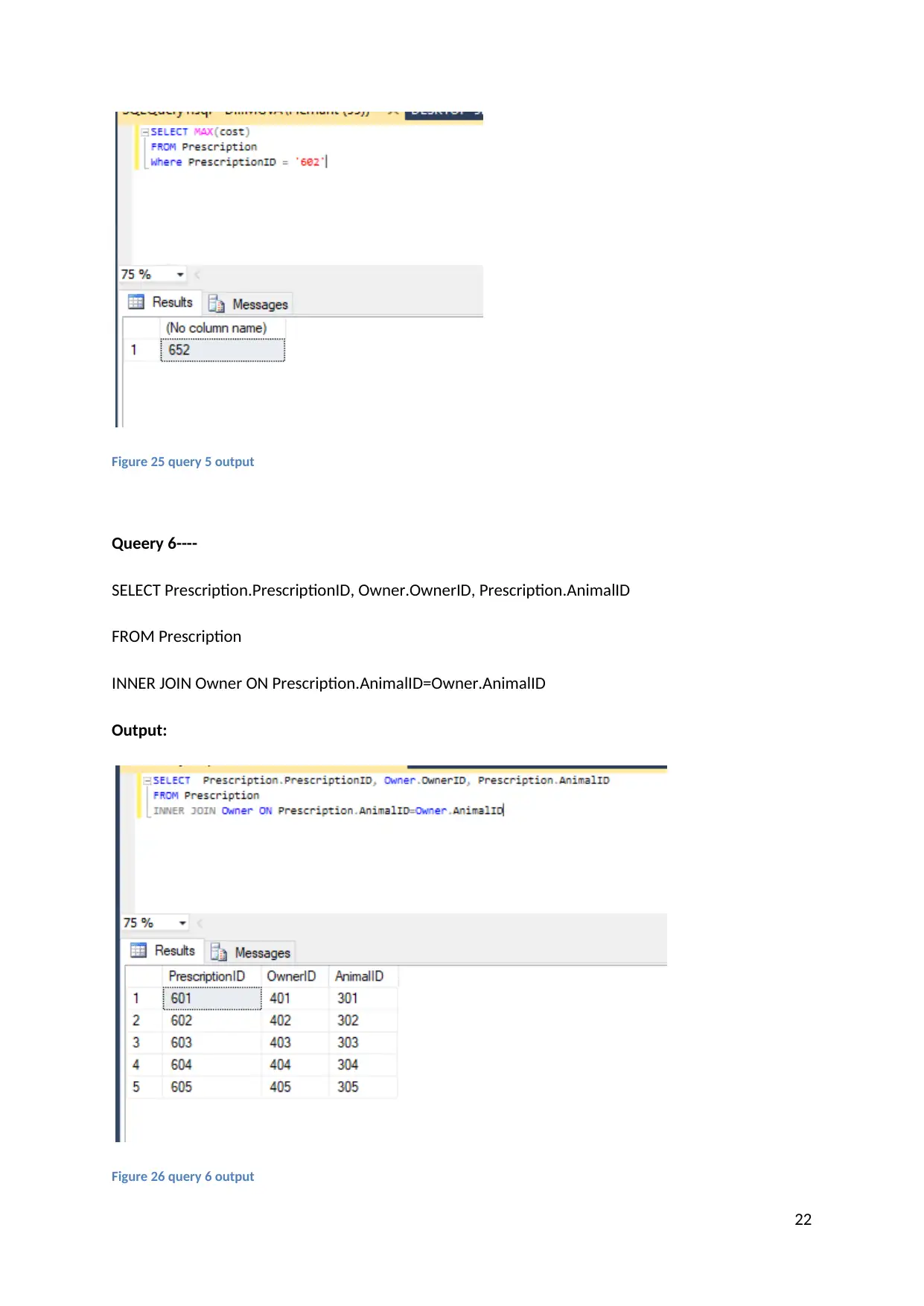
Figure 25 query 5 output
Queery 6----
SELECT Prescription.PrescriptionID, Owner.OwnerID, Prescription.AnimalID
FROM Prescription
INNER JOIN Owner ON Prescription.AnimalID=Owner.AnimalID
Output:
Figure 26 query 6 output
22
Queery 6----
SELECT Prescription.PrescriptionID, Owner.OwnerID, Prescription.AnimalID
FROM Prescription
INNER JOIN Owner ON Prescription.AnimalID=Owner.AnimalID
Output:
Figure 26 query 6 output
22
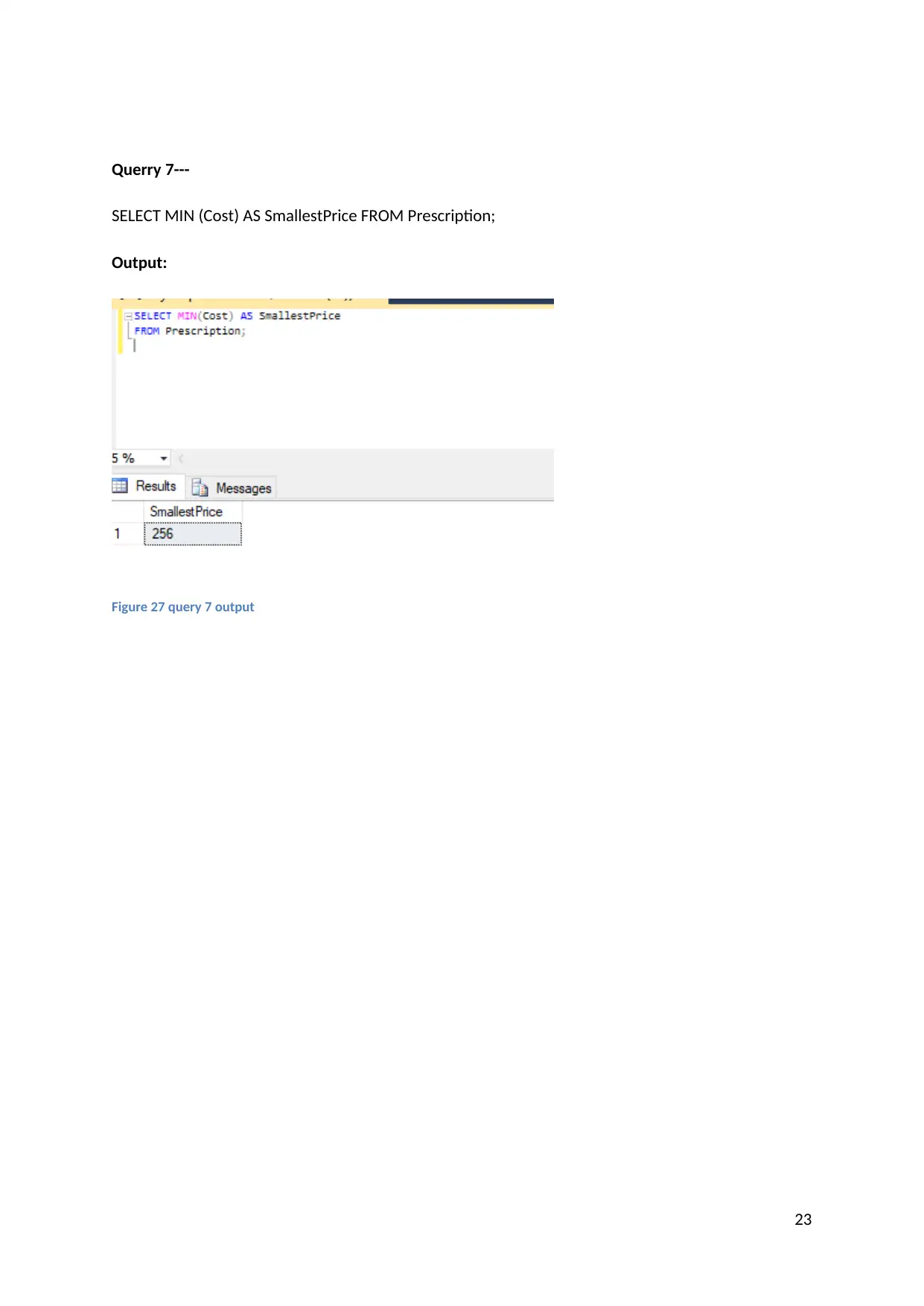
Querry 7---
SELECT MIN (Cost) AS SmallestPrice FROM Prescription;
Output:
Figure 27 query 7 output
23
SELECT MIN (Cost) AS SmallestPrice FROM Prescription;
Output:
Figure 27 query 7 output
23

M2 Implement a fully functional database system which includes system security
and database maintenance.
For the VET arrangement database game plan tables are composed, to get the rule target that is
bolstering. Moreover, the field information outline is indicated for every single field to fabricate the
security of the database. This would protect the database from wrong sections. The customer can't
enter the data in wrong association along these lines. If the customer enters the data in wrong game
plan for example if customer input the name in the wrong arrangement that is numeric design than
a VET arrangement database structure will give a mistake for "wrong data association" and area
won't be secured in the VET arrangement database. Moreover, the endorsement oversee is
associated with the basic key area with the objective that no customer can leave the portion empty
for the basic imperative field. This would achieve the protected database (Elmasri, and Navathe,
2016)
24
and database maintenance.
For the VET arrangement database game plan tables are composed, to get the rule target that is
bolstering. Moreover, the field information outline is indicated for every single field to fabricate the
security of the database. This would protect the database from wrong sections. The customer can't
enter the data in wrong association along these lines. If the customer enters the data in wrong game
plan for example if customer input the name in the wrong arrangement that is numeric design than
a VET arrangement database structure will give a mistake for "wrong data association" and area
won't be secured in the VET arrangement database. Moreover, the endorsement oversee is
associated with the basic key area with the objective that no customer can leave the portion empty
for the basic imperative field. This would achieve the protected database (Elmasri, and Navathe,
2016)
24
Paraphrase This Document
Need a fresh take? Get an instant paraphrase of this document with our AI Paraphraser
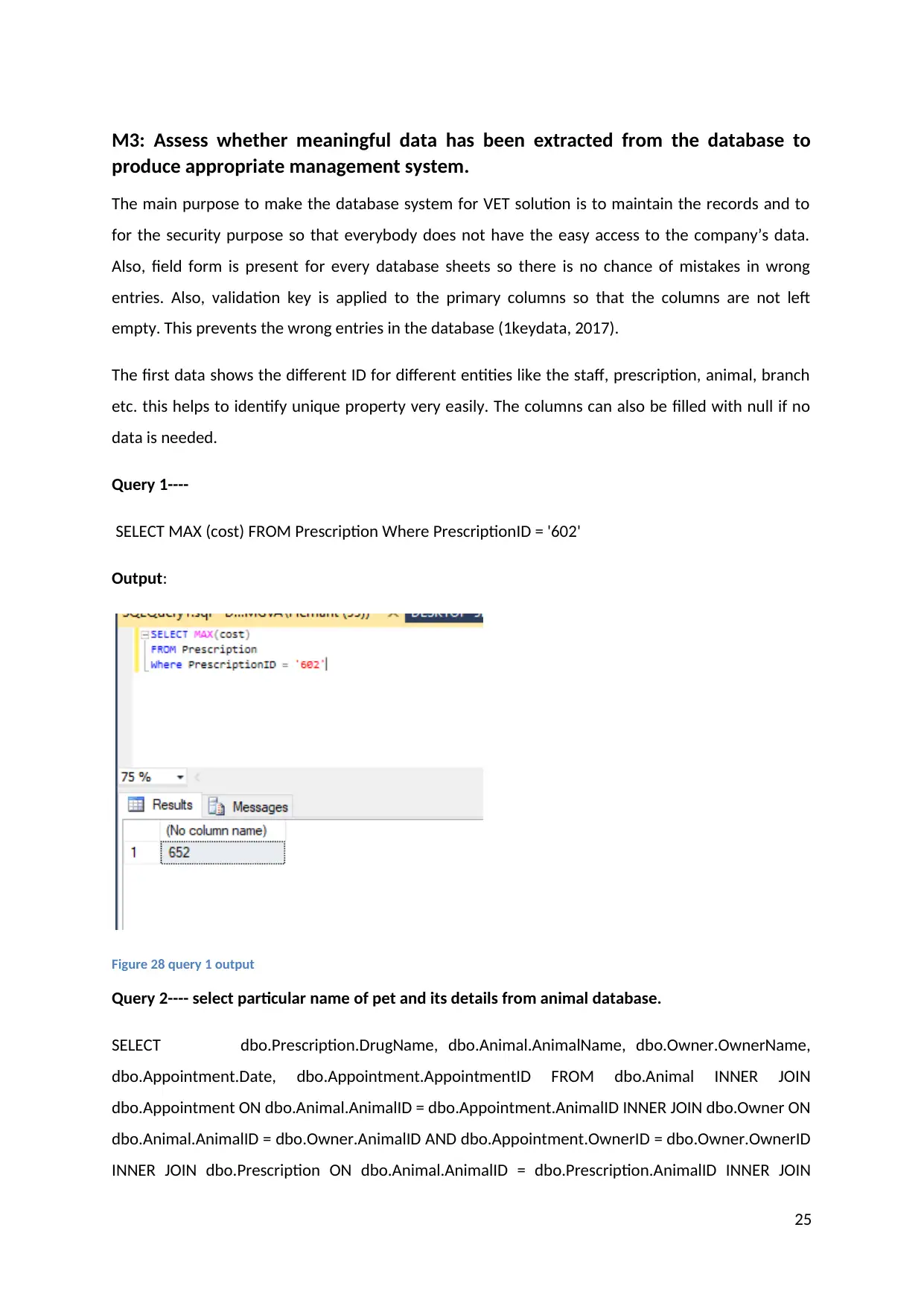
M3: Assess whether meaningful data has been extracted from the database to
produce appropriate management system.
The main purpose to make the database system for VET solution is to maintain the records and to
for the security purpose so that everybody does not have the easy access to the company’s data.
Also, field form is present for every database sheets so there is no chance of mistakes in wrong
entries. Also, validation key is applied to the primary columns so that the columns are not left
empty. This prevents the wrong entries in the database (1keydata, 2017).
The first data shows the different ID for different entities like the staff, prescription, animal, branch
etc. this helps to identify unique property very easily. The columns can also be filled with null if no
data is needed.
Query 1----
SELECT MAX (cost) FROM Prescription Where PrescriptionID = '602'
Output:
Figure 28 query 1 output
Query 2---- select particular name of pet and its details from animal database.
SELECT dbo.Prescription.DrugName, dbo.Animal.AnimalName, dbo.Owner.OwnerName,
dbo.Appointment.Date, dbo.Appointment.AppointmentID FROM dbo.Animal INNER JOIN
dbo.Appointment ON dbo.Animal.AnimalID = dbo.Appointment.AnimalID INNER JOIN dbo.Owner ON
dbo.Animal.AnimalID = dbo.Owner.AnimalID AND dbo.Appointment.OwnerID = dbo.Owner.OwnerID
INNER JOIN dbo.Prescription ON dbo.Animal.AnimalID = dbo.Prescription.AnimalID INNER JOIN
25
produce appropriate management system.
The main purpose to make the database system for VET solution is to maintain the records and to
for the security purpose so that everybody does not have the easy access to the company’s data.
Also, field form is present for every database sheets so there is no chance of mistakes in wrong
entries. Also, validation key is applied to the primary columns so that the columns are not left
empty. This prevents the wrong entries in the database (1keydata, 2017).
The first data shows the different ID for different entities like the staff, prescription, animal, branch
etc. this helps to identify unique property very easily. The columns can also be filled with null if no
data is needed.
Query 1----
SELECT MAX (cost) FROM Prescription Where PrescriptionID = '602'
Output:
Figure 28 query 1 output
Query 2---- select particular name of pet and its details from animal database.
SELECT dbo.Prescription.DrugName, dbo.Animal.AnimalName, dbo.Owner.OwnerName,
dbo.Appointment.Date, dbo.Appointment.AppointmentID FROM dbo.Animal INNER JOIN
dbo.Appointment ON dbo.Animal.AnimalID = dbo.Appointment.AnimalID INNER JOIN dbo.Owner ON
dbo.Animal.AnimalID = dbo.Owner.AnimalID AND dbo.Appointment.OwnerID = dbo.Owner.OwnerID
INNER JOIN dbo.Prescription ON dbo.Animal.AnimalID = dbo.Prescription.AnimalID INNER JOIN
25
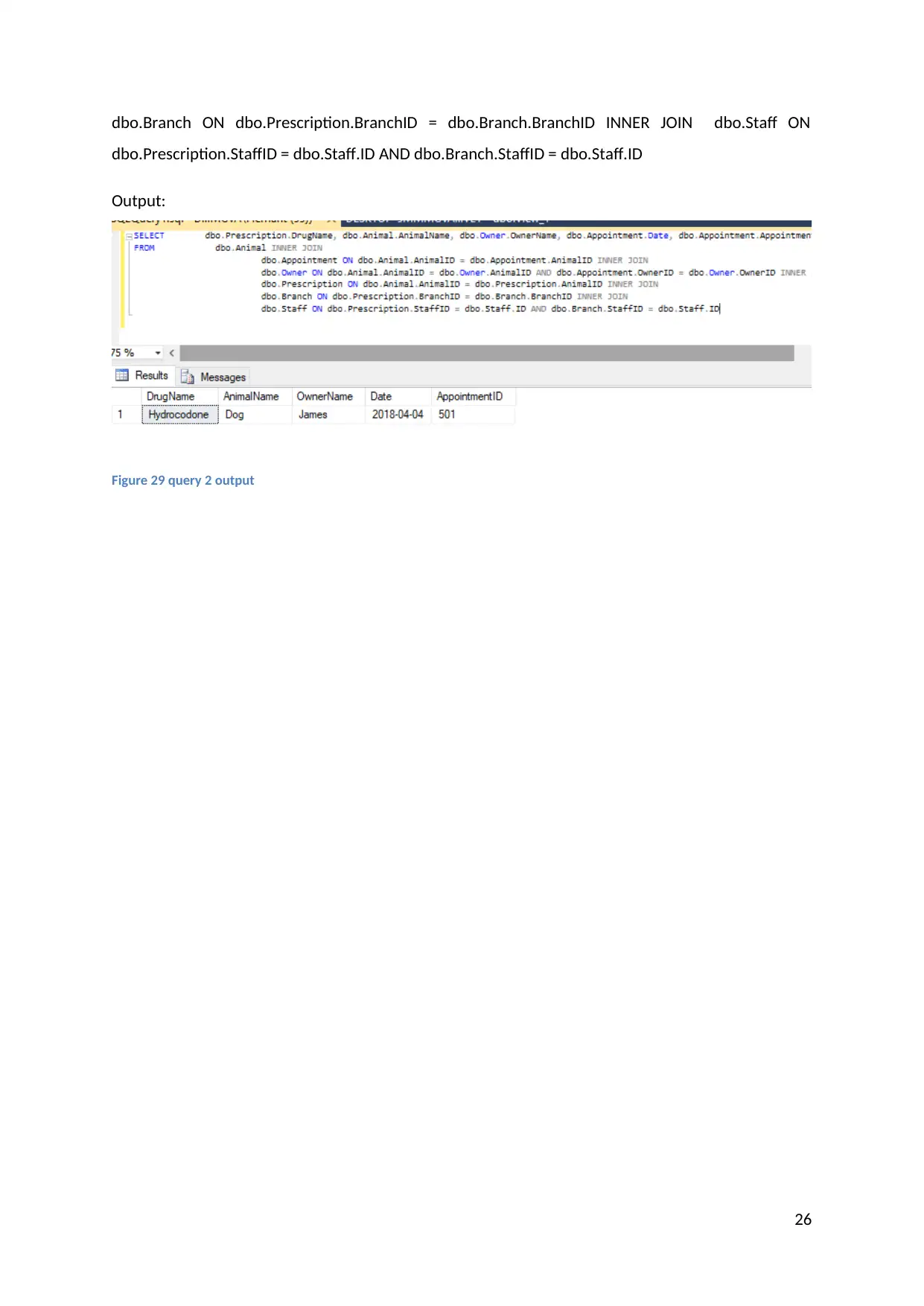
dbo.Branch ON dbo.Prescription.BranchID = dbo.Branch.BranchID INNER JOIN dbo.Staff ON
dbo.Prescription.StaffID = dbo.Staff.ID AND dbo.Branch.StaffID = dbo.Staff.ID
Output:
Figure 29 query 2 output
26
dbo.Prescription.StaffID = dbo.Staff.ID AND dbo.Branch.StaffID = dbo.Staff.ID
Output:
Figure 29 query 2 output
26
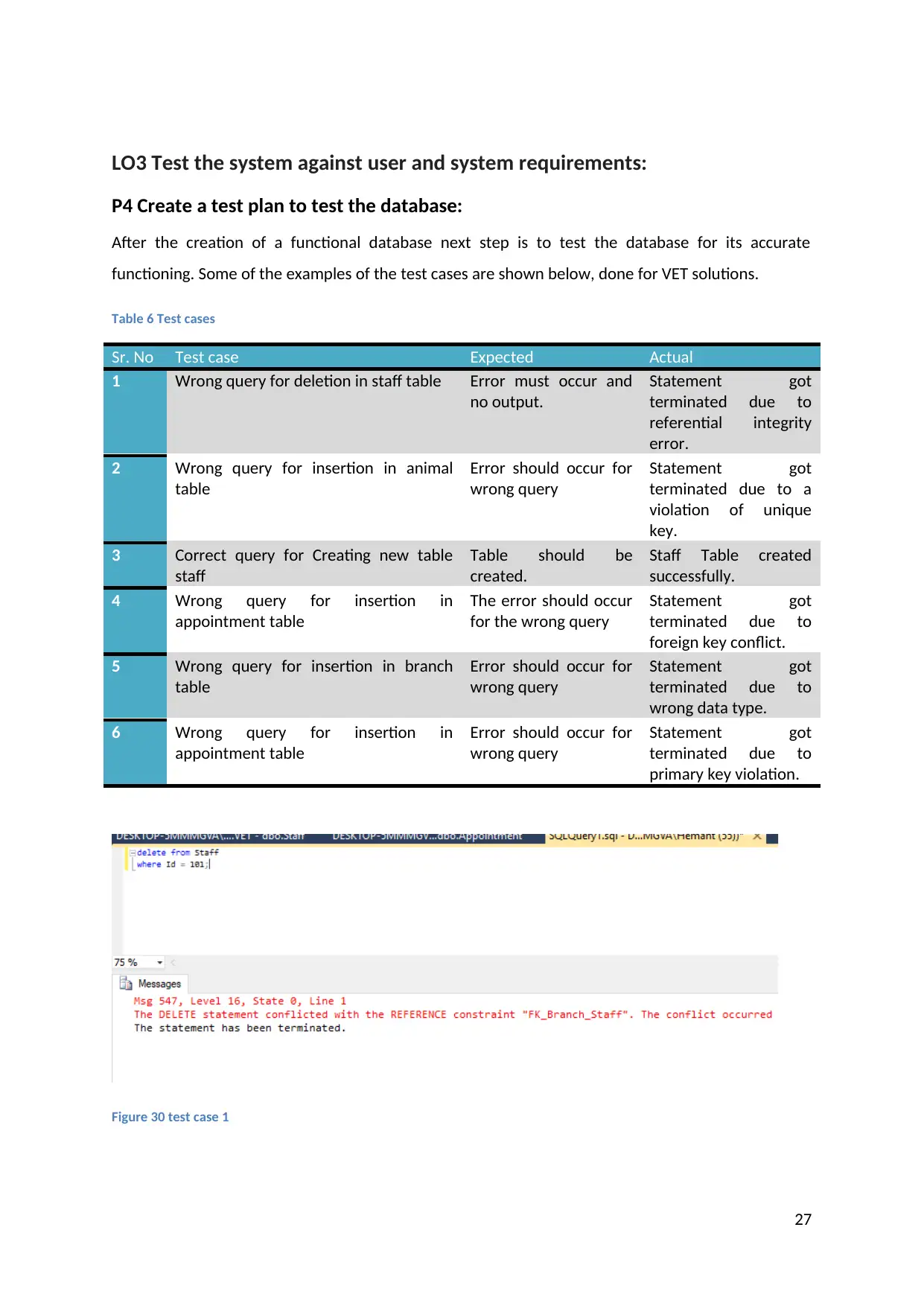
LO3 Test the system against user and system requirements:
P4 Create a test plan to test the database:
After the creation of a functional database next step is to test the database for its accurate
functioning. Some of the examples of the test cases are shown below, done for VET solutions.
Table 6 Test cases
Sr. No Test case Expected Actual
1 Wrong query for deletion in staff table Error must occur and
no output.
Statement got
terminated due to
referential integrity
error.
2 Wrong query for insertion in animal
table
Error should occur for
wrong query
Statement got
terminated due to a
violation of unique
key.
3 Correct query for Creating new table
staff
Table should be
created.
Staff Table created
successfully.
4 Wrong query for insertion in
appointment table
The error should occur
for the wrong query
Statement got
terminated due to
foreign key conflict.
5 Wrong query for insertion in branch
table
Error should occur for
wrong query
Statement got
terminated due to
wrong data type.
6 Wrong query for insertion in
appointment table
Error should occur for
wrong query
Statement got
terminated due to
primary key violation.
Figure 30 test case 1
27
P4 Create a test plan to test the database:
After the creation of a functional database next step is to test the database for its accurate
functioning. Some of the examples of the test cases are shown below, done for VET solutions.
Table 6 Test cases
Sr. No Test case Expected Actual
1 Wrong query for deletion in staff table Error must occur and
no output.
Statement got
terminated due to
referential integrity
error.
2 Wrong query for insertion in animal
table
Error should occur for
wrong query
Statement got
terminated due to a
violation of unique
key.
3 Correct query for Creating new table
staff
Table should be
created.
Staff Table created
successfully.
4 Wrong query for insertion in
appointment table
The error should occur
for the wrong query
Statement got
terminated due to
foreign key conflict.
5 Wrong query for insertion in branch
table
Error should occur for
wrong query
Statement got
terminated due to
wrong data type.
6 Wrong query for insertion in
appointment table
Error should occur for
wrong query
Statement got
terminated due to
primary key violation.
Figure 30 test case 1
27
Secure Best Marks with AI Grader
Need help grading? Try our AI Grader for instant feedback on your assignments.
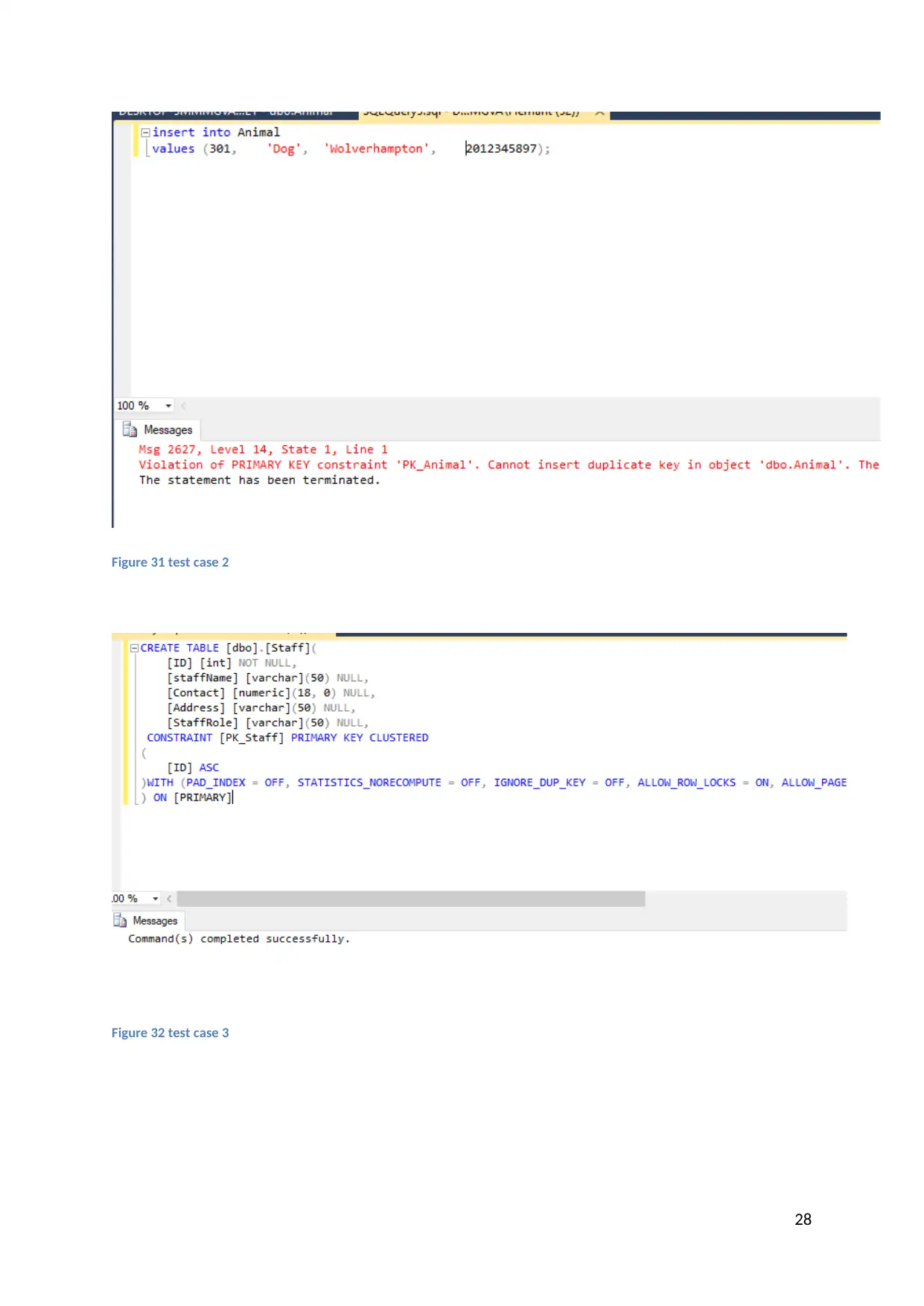
Figure 31 test case 2
Figure 32 test case 3
28
Figure 32 test case 3
28
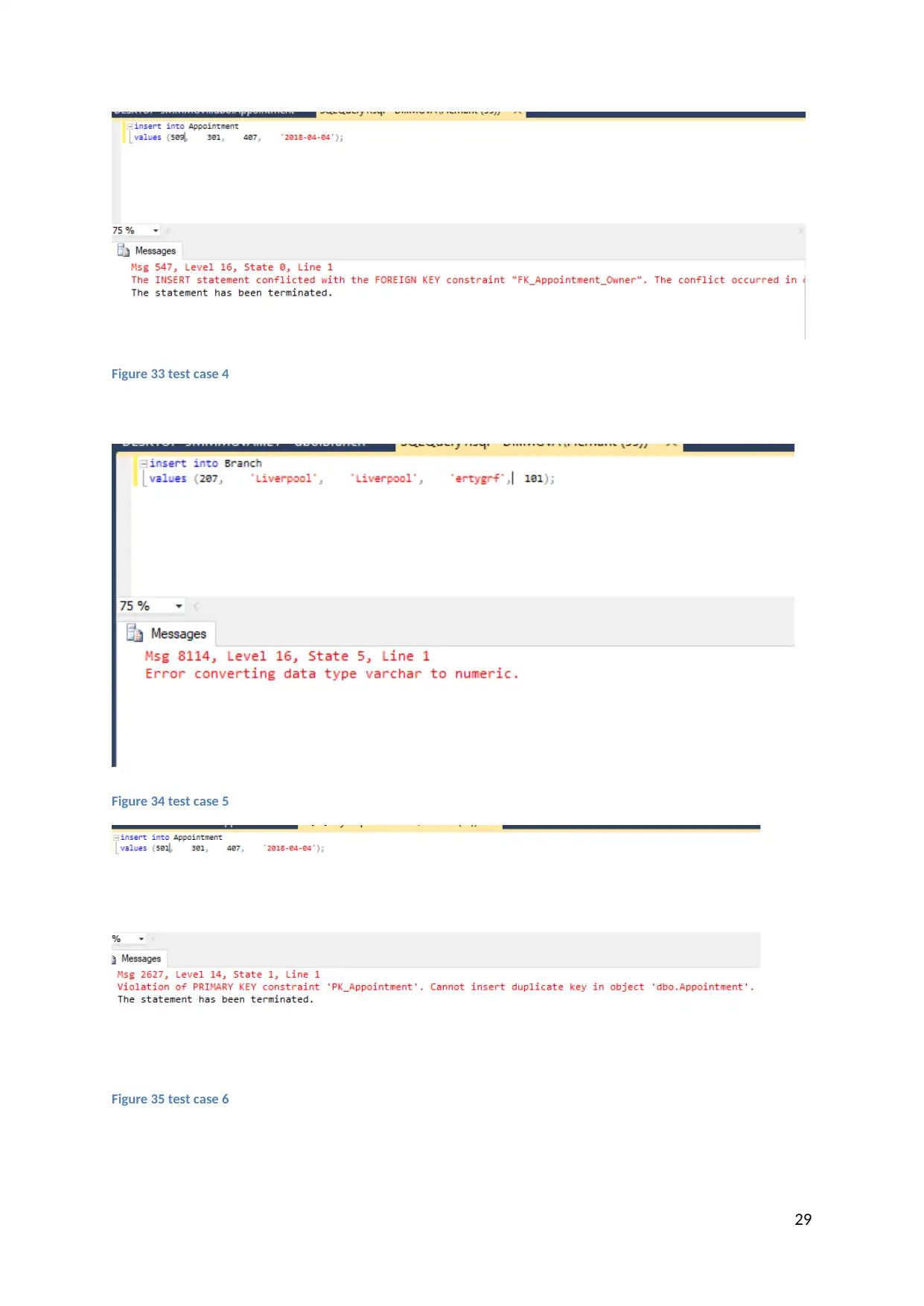
Figure 33 test case 4
Figure 34 test case 5
Figure 35 test case 6
29
Figure 34 test case 5
Figure 35 test case 6
29
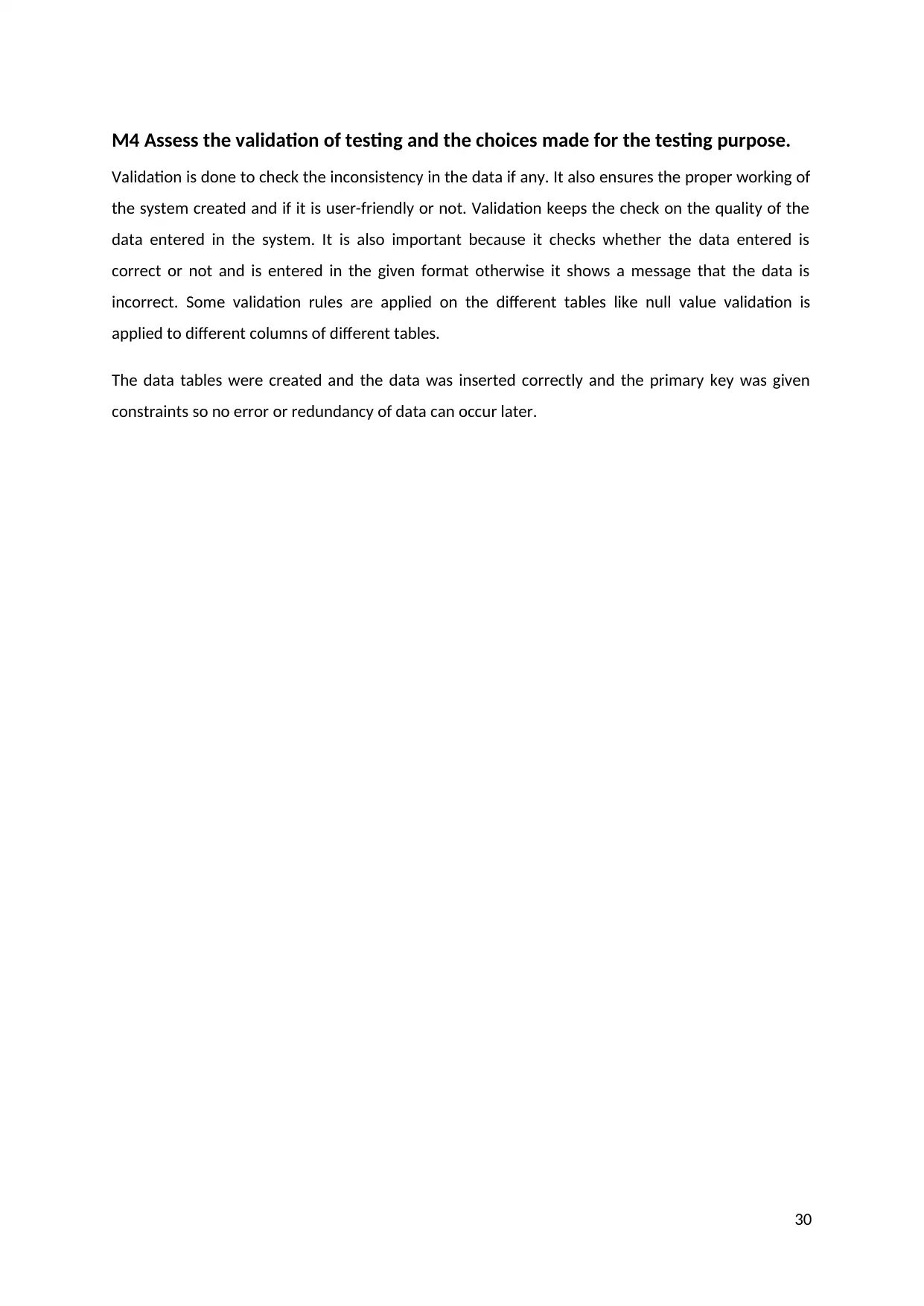
M4 Assess the validation of testing and the choices made for the testing purpose.
Validation is done to check the inconsistency in the data if any. It also ensures the proper working of
the system created and if it is user-friendly or not. Validation keeps the check on the quality of the
data entered in the system. It is also important because it checks whether the data entered is
correct or not and is entered in the given format otherwise it shows a message that the data is
incorrect. Some validation rules are applied on the different tables like null value validation is
applied to different columns of different tables.
The data tables were created and the data was inserted correctly and the primary key was given
constraints so no error or redundancy of data can occur later.
30
Validation is done to check the inconsistency in the data if any. It also ensures the proper working of
the system created and if it is user-friendly or not. Validation keeps the check on the quality of the
data entered in the system. It is also important because it checks whether the data entered is
correct or not and is entered in the given format otherwise it shows a message that the data is
incorrect. Some validation rules are applied on the different tables like null value validation is
applied to different columns of different tables.
The data tables were created and the data was inserted correctly and the primary key was given
constraints so no error or redundancy of data can occur later.
30
Paraphrase This Document
Need a fresh take? Get an instant paraphrase of this document with our AI Paraphraser
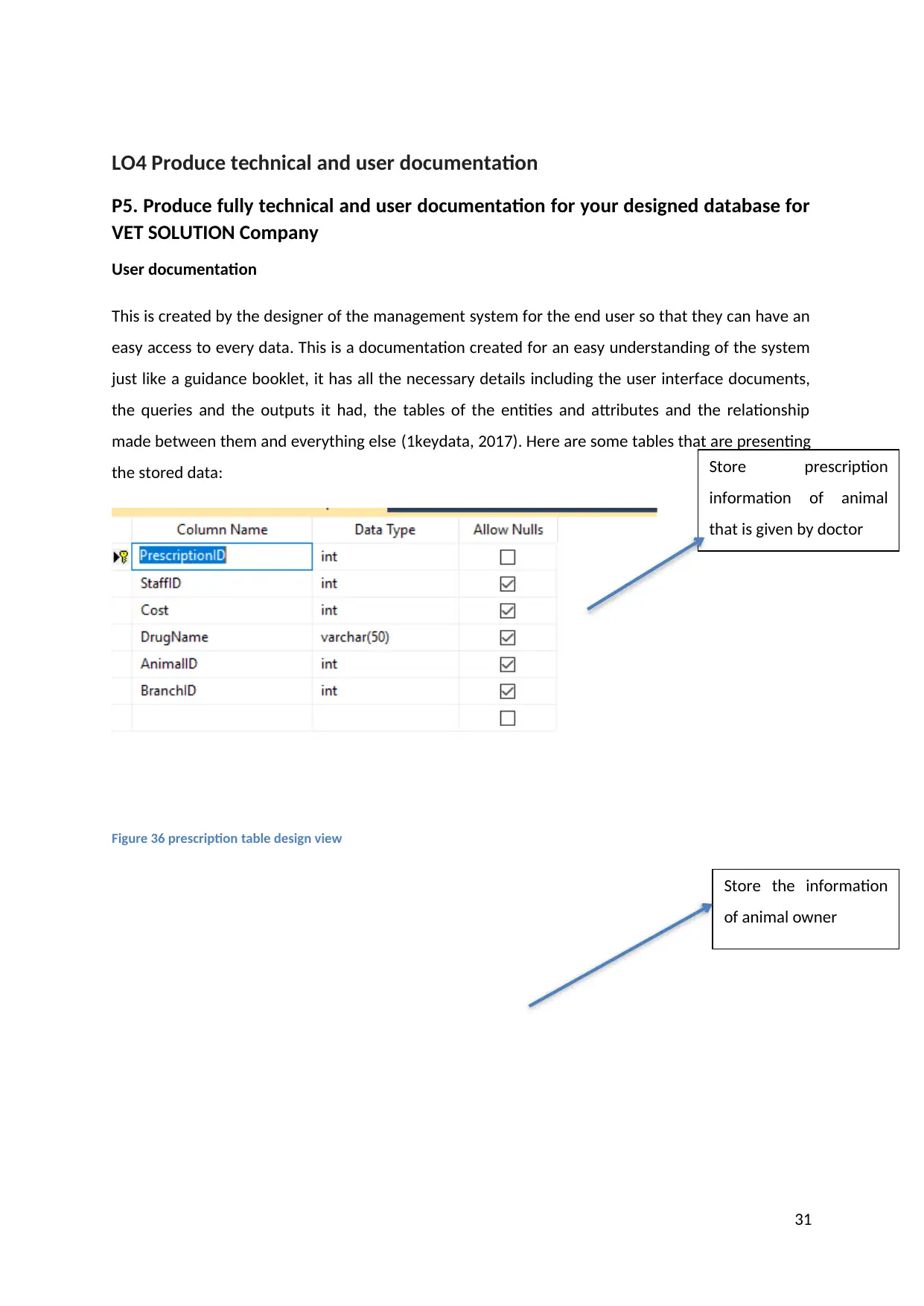
LO4 Produce technical and user documentation
P5. Produce fully technical and user documentation for your designed database for
VET SOLUTION Company
User documentation
This is created by the designer of the management system for the end user so that they can have an
easy access to every data. This is a documentation created for an easy understanding of the system
just like a guidance booklet, it has all the necessary details including the user interface documents,
the queries and the outputs it had, the tables of the entities and attributes and the relationship
made between them and everything else (1keydata, 2017). Here are some tables that are presenting
the stored data:
Figure 36 prescription table design view
31
Store prescription
information of animal
that is given by doctor
Store the information
of animal owner
P5. Produce fully technical and user documentation for your designed database for
VET SOLUTION Company
User documentation
This is created by the designer of the management system for the end user so that they can have an
easy access to every data. This is a documentation created for an easy understanding of the system
just like a guidance booklet, it has all the necessary details including the user interface documents,
the queries and the outputs it had, the tables of the entities and attributes and the relationship
made between them and everything else (1keydata, 2017). Here are some tables that are presenting
the stored data:
Figure 36 prescription table design view
31
Store prescription
information of animal
that is given by doctor
Store the information
of animal owner
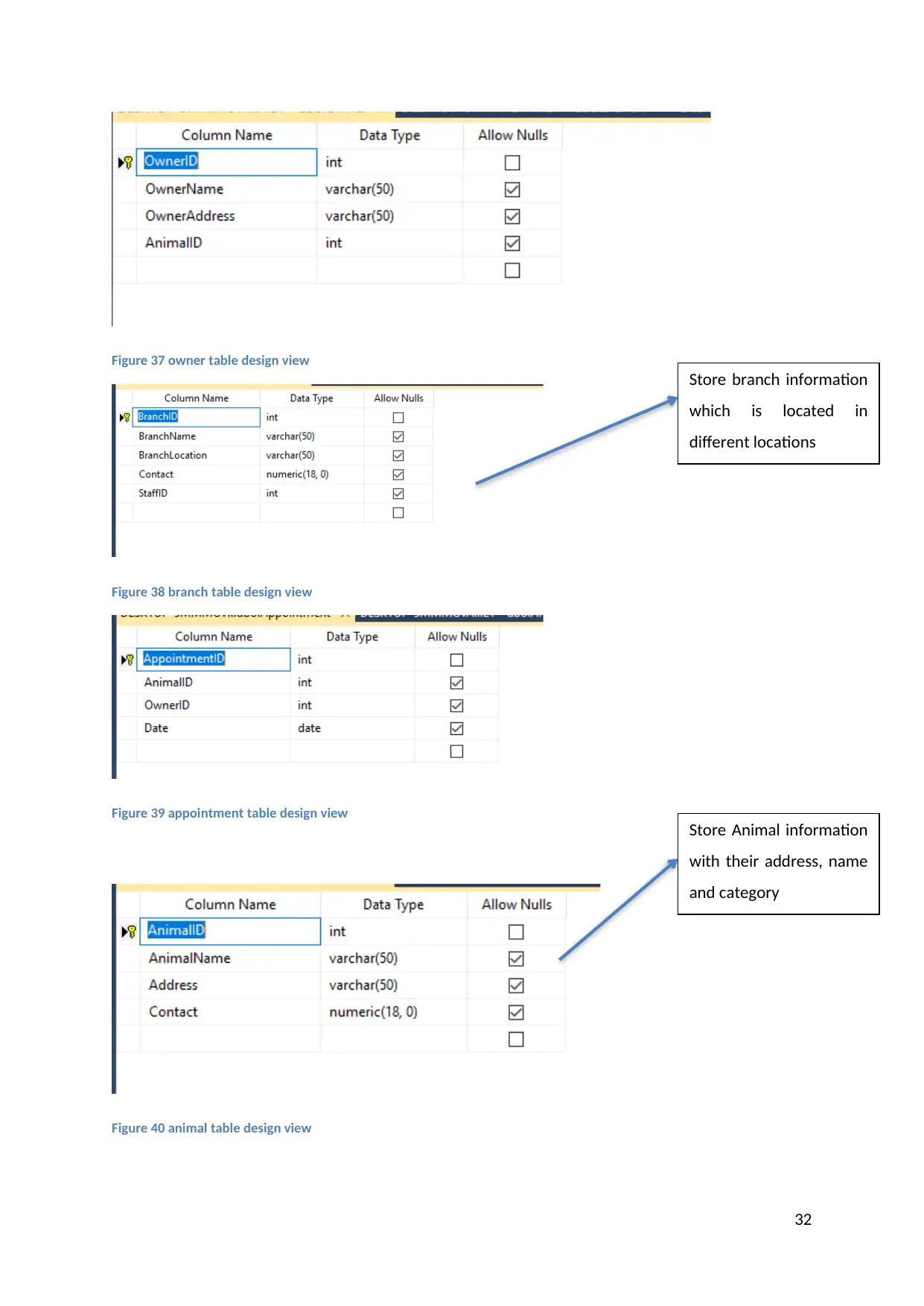
Figure 37 owner table design view
Figure 38 branch table design view
Figure 39 appointment table design view
Figure 40 animal table design view
32
Store branch information
which is located in
different locations
Store Animal information
with their address, name
and category
Figure 38 branch table design view
Figure 39 appointment table design view
Figure 40 animal table design view
32
Store branch information
which is located in
different locations
Store Animal information
with their address, name
and category
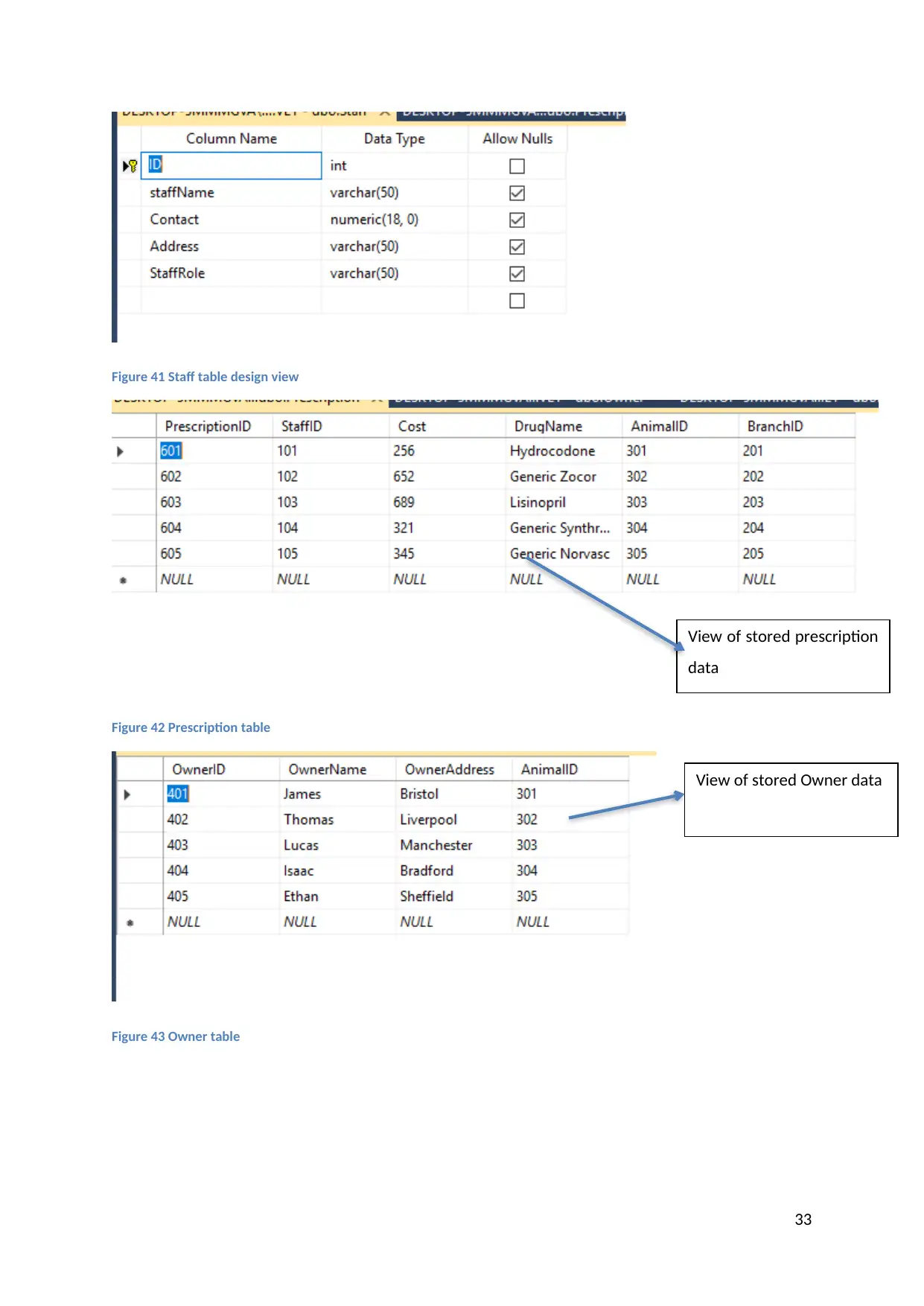
Figure 41 Staff table design view
Figure 42 Prescription table
Figure 43 Owner table
33
View of stored prescription
data
View of stored Owner data
Figure 42 Prescription table
Figure 43 Owner table
33
View of stored prescription
data
View of stored Owner data
Secure Best Marks with AI Grader
Need help grading? Try our AI Grader for instant feedback on your assignments.

Figure 44 Branch Table
Figure 45 Appointment table
Figure 46 animal Table
34
View of stored
Appointment information
View of stored staff
information as name, id,
contact address etc.
Figure 45 Appointment table
Figure 46 animal Table
34
View of stored
Appointment information
View of stored staff
information as name, id,
contact address etc.
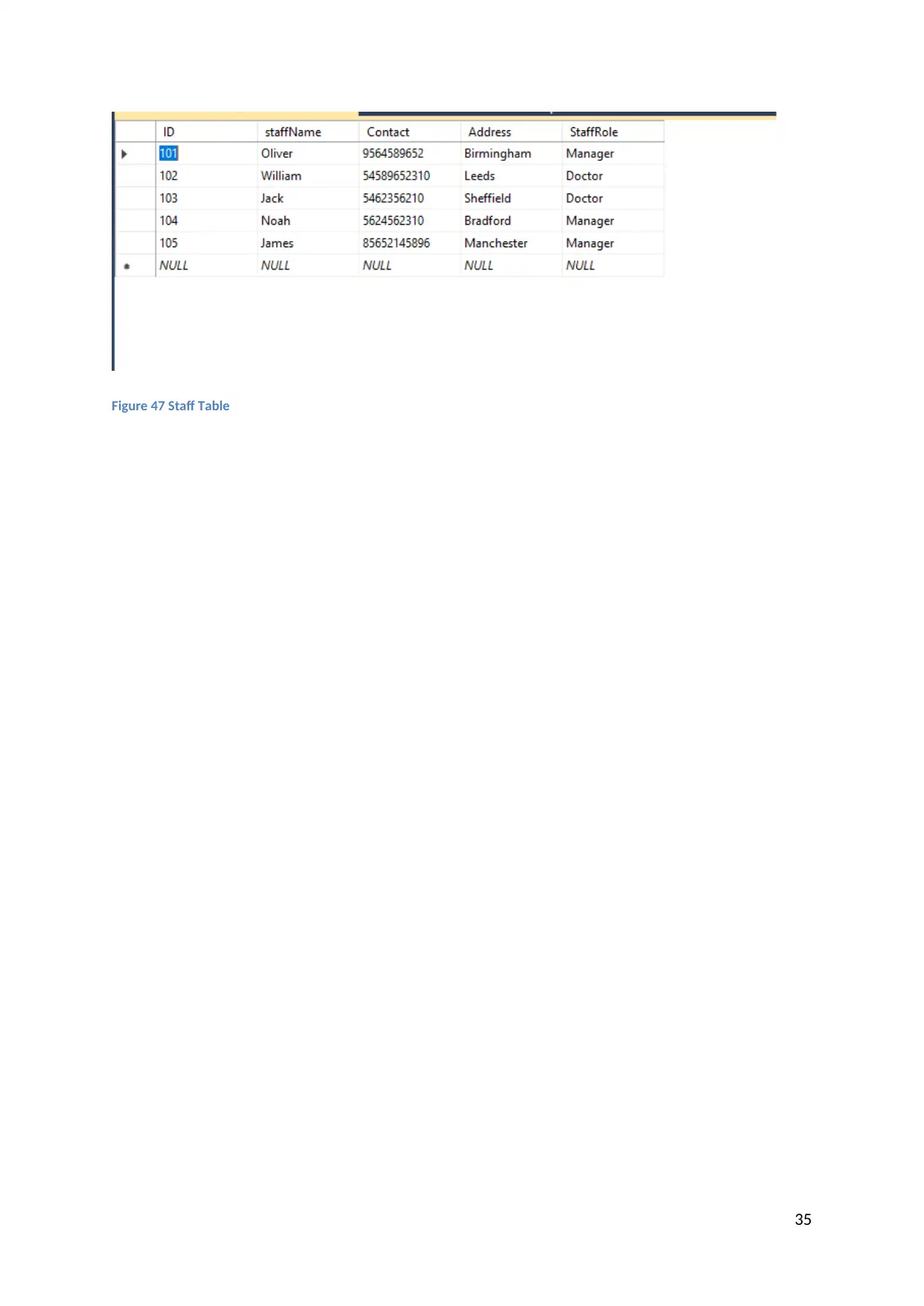
Figure 47 Staff Table
35
35

Technical documentation
In this technical documentation, we have all the necessary information which is technically related
to the VET solution Company. This is made for proper management in the company. This includes
the functional dependency of the database made and the relationship among different tables is
found and documented (Graubner, 2017).
Animal
AnimalID
AnimalName
Address
Contact
Appointment
AppointmentID
AnimalID
OwnerID
Date
Branch
BranchID
BranchName
BranchLocation
Contact
StaffID
Owner
OwnerID
OwnerName
OwnerAddress
AnimalID
Prescription
PrescriptionID
StaffID
Cost
DrugName
AnimalID
BranchID
Staff
ID
staffName
Contact
Address
StaffRole
Figure 48 relationship diagram
Figure 49 query 5 output
36
Calculate the maximum cost
according the prescription id
In this technical documentation, we have all the necessary information which is technically related
to the VET solution Company. This is made for proper management in the company. This includes
the functional dependency of the database made and the relationship among different tables is
found and documented (Graubner, 2017).
Animal
AnimalID
AnimalName
Address
Contact
Appointment
AppointmentID
AnimalID
OwnerID
Date
Branch
BranchID
BranchName
BranchLocation
Contact
StaffID
Owner
OwnerID
OwnerName
OwnerAddress
AnimalID
Prescription
PrescriptionID
StaffID
Cost
DrugName
AnimalID
BranchID
Staff
ID
staffName
Contact
Address
StaffRole
Figure 48 relationship diagram
Figure 49 query 5 output
36
Calculate the maximum cost
according the prescription id
Paraphrase This Document
Need a fresh take? Get an instant paraphrase of this document with our AI Paraphraser
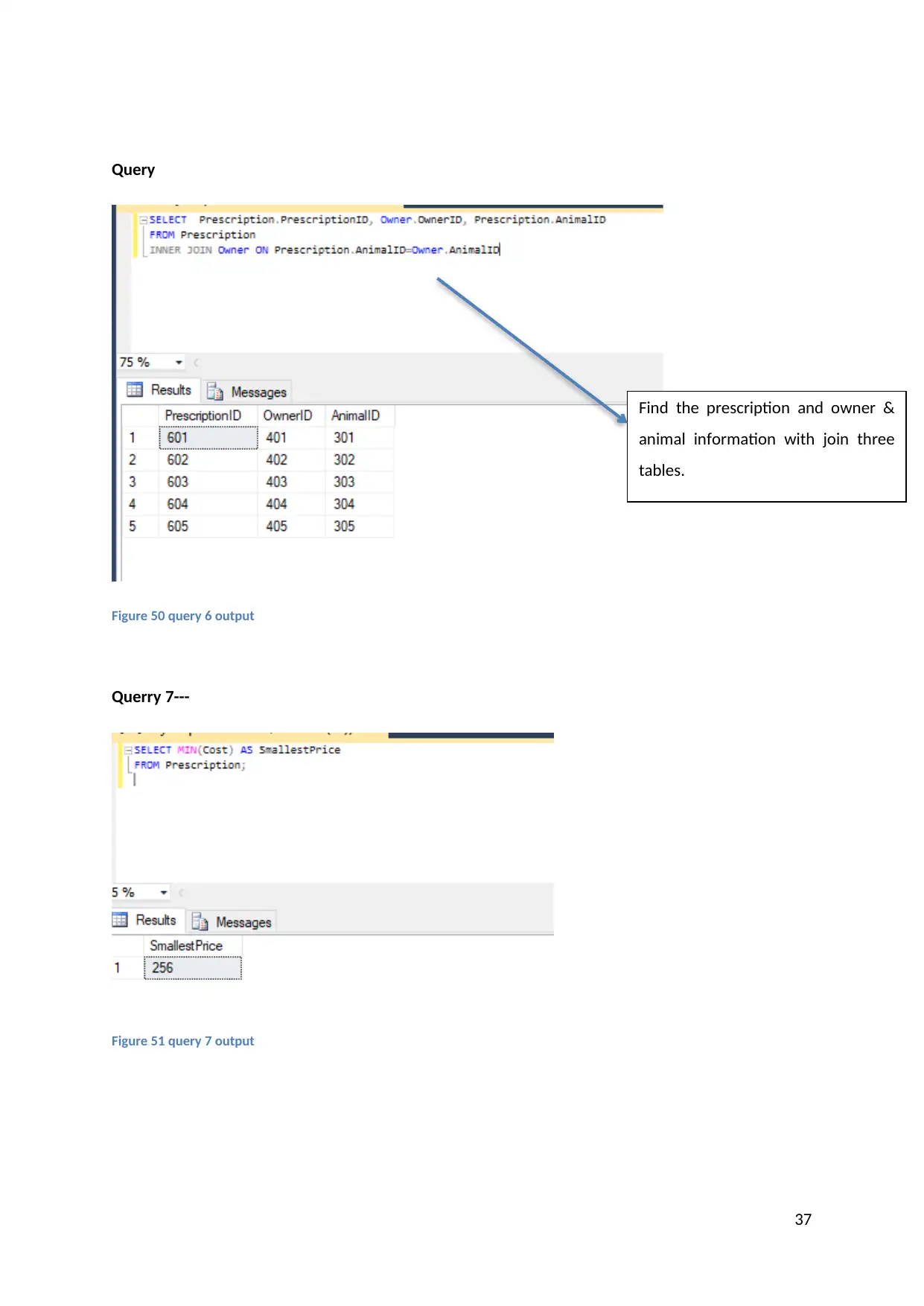
Query
Figure 50 query 6 output
Querry 7---
Figure 51 query 7 output
37
Find the prescription and owner &
animal information with join three
tables.
Figure 50 query 6 output
Querry 7---
Figure 51 query 7 output
37
Find the prescription and owner &
animal information with join three
tables.
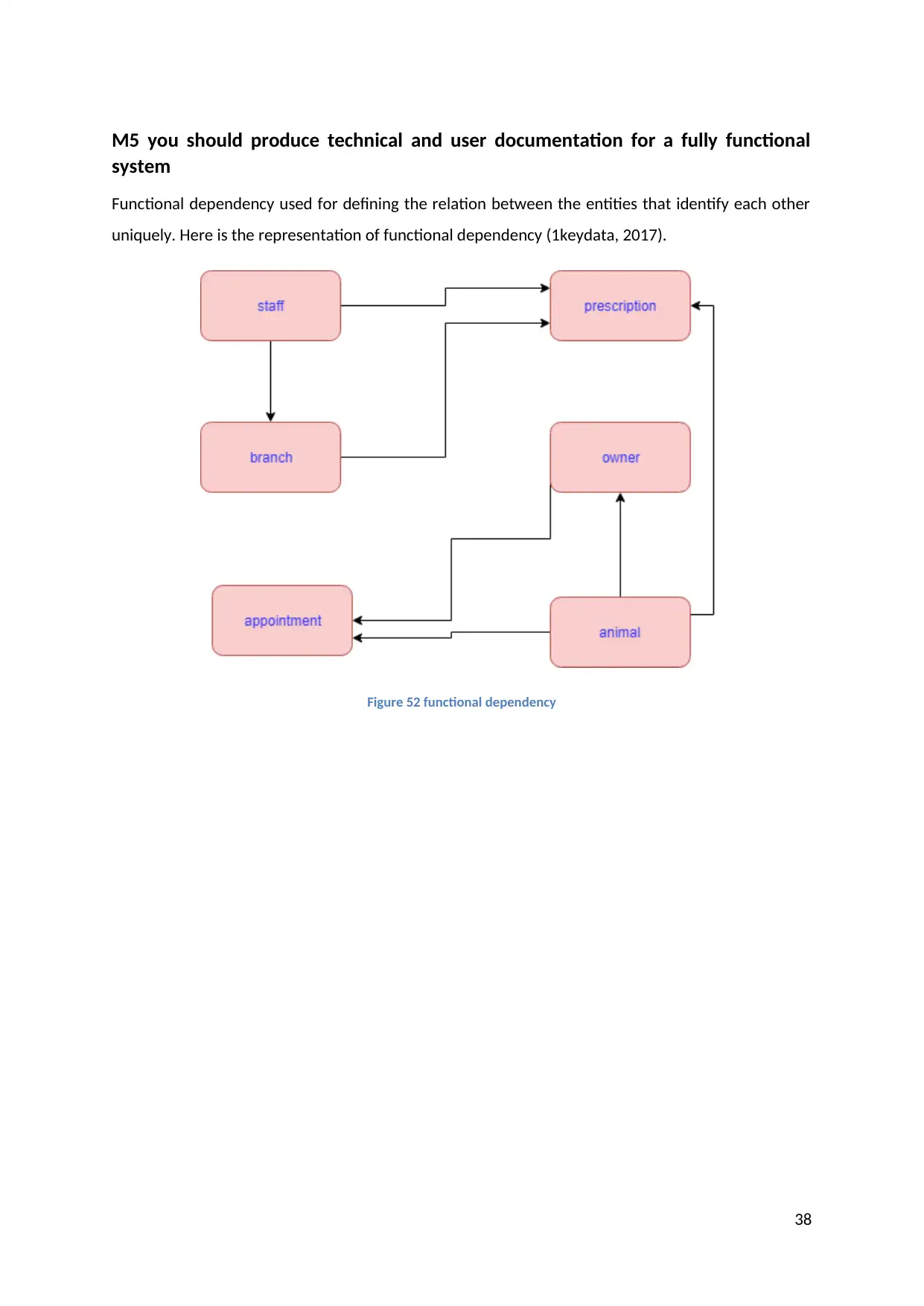
M5 you should produce technical and user documentation for a fully functional
system
Functional dependency used for defining the relation between the entities that identify each other
uniquely. Here is the representation of functional dependency (1keydata, 2017).
Figure 52 functional dependency
38
system
Functional dependency used for defining the relation between the entities that identify each other
uniquely. Here is the representation of functional dependency (1keydata, 2017).
Figure 52 functional dependency
38
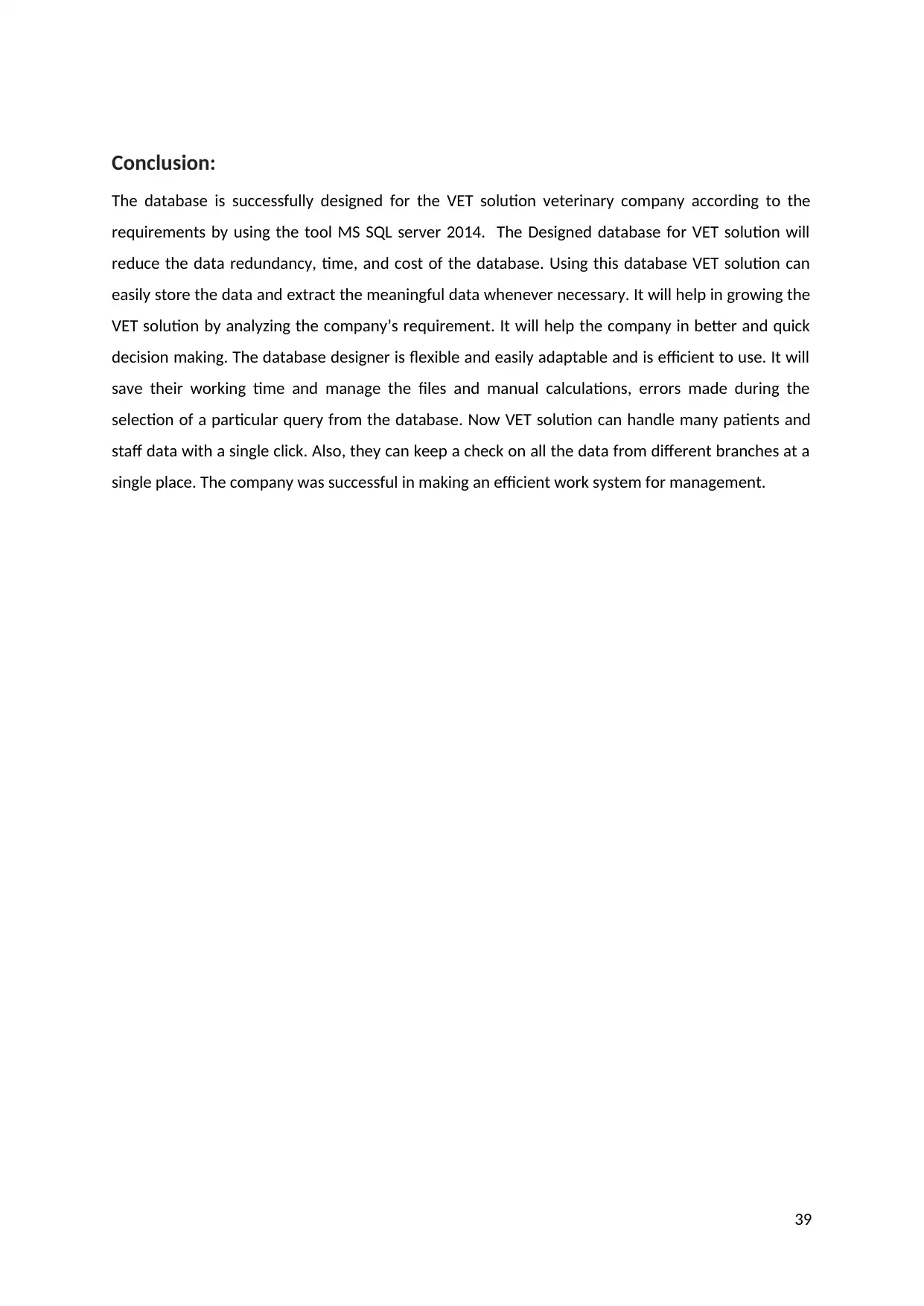
Conclusion:
The database is successfully designed for the VET solution veterinary company according to the
requirements by using the tool MS SQL server 2014. The Designed database for VET solution will
reduce the data redundancy, time, and cost of the database. Using this database VET solution can
easily store the data and extract the meaningful data whenever necessary. It will help in growing the
VET solution by analyzing the company’s requirement. It will help the company in better and quick
decision making. The database designer is flexible and easily adaptable and is efficient to use. It will
save their working time and manage the files and manual calculations, errors made during the
selection of a particular query from the database. Now VET solution can handle many patients and
staff data with a single click. Also, they can keep a check on all the data from different branches at a
single place. The company was successful in making an efficient work system for management.
39
The database is successfully designed for the VET solution veterinary company according to the
requirements by using the tool MS SQL server 2014. The Designed database for VET solution will
reduce the data redundancy, time, and cost of the database. Using this database VET solution can
easily store the data and extract the meaningful data whenever necessary. It will help in growing the
VET solution by analyzing the company’s requirement. It will help the company in better and quick
decision making. The database designer is flexible and easily adaptable and is efficient to use. It will
save their working time and manage the files and manual calculations, errors made during the
selection of a particular query from the database. Now VET solution can handle many patients and
staff data with a single click. Also, they can keep a check on all the data from different branches at a
single place. The company was successful in making an efficient work system for management.
39
Secure Best Marks with AI Grader
Need help grading? Try our AI Grader for instant feedback on your assignments.
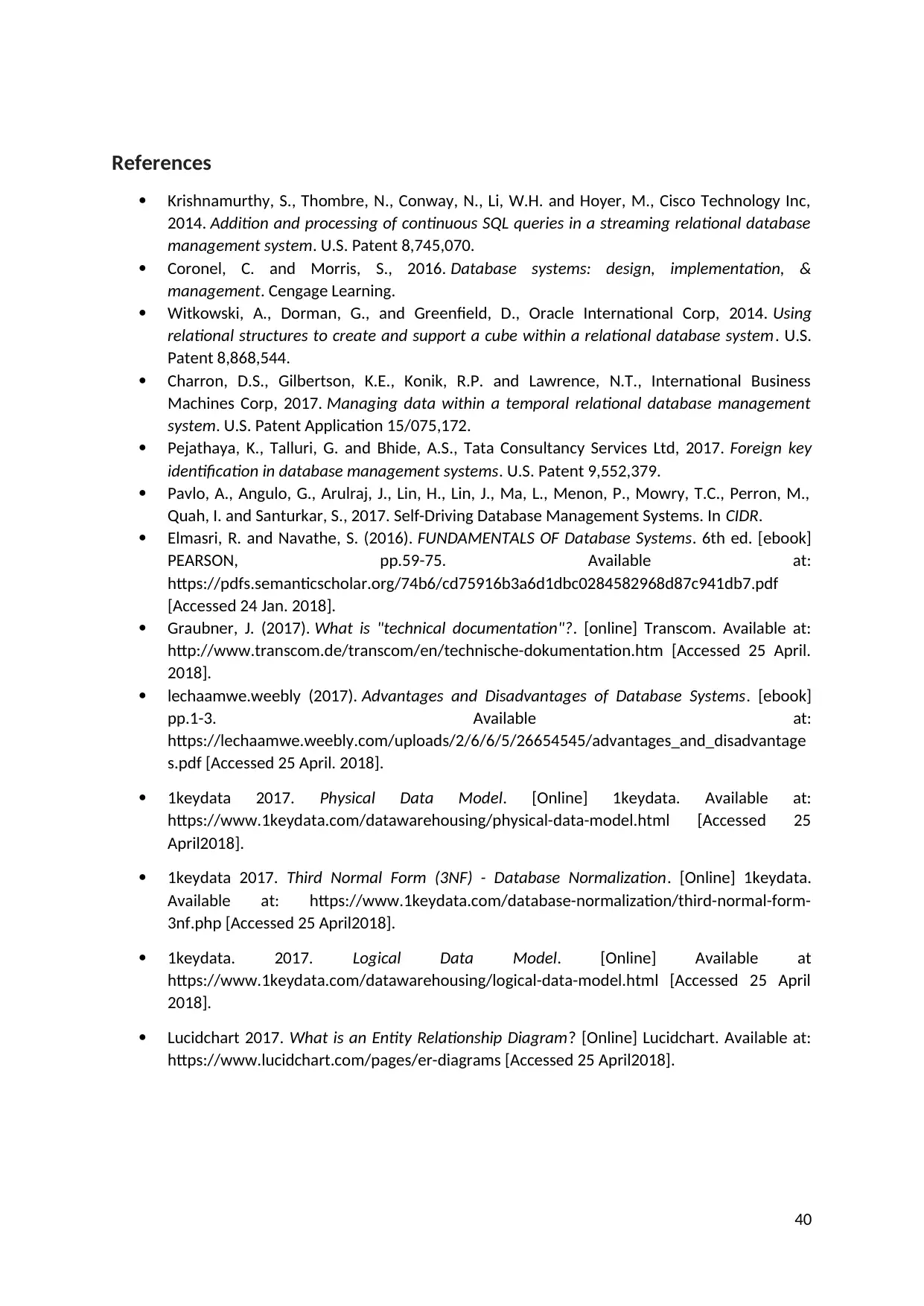
References
Krishnamurthy, S., Thombre, N., Conway, N., Li, W.H. and Hoyer, M., Cisco Technology Inc,
2014. Addition and processing of continuous SQL queries in a streaming relational database
management system. U.S. Patent 8,745,070.
Coronel, C. and Morris, S., 2016. Database systems: design, implementation, &
management. Cengage Learning.
Witkowski, A., Dorman, G., and Greenfield, D., Oracle International Corp, 2014. Using
relational structures to create and support a cube within a relational database system. U.S.
Patent 8,868,544.
Charron, D.S., Gilbertson, K.E., Konik, R.P. and Lawrence, N.T., International Business
Machines Corp, 2017. Managing data within a temporal relational database management
system. U.S. Patent Application 15/075,172.
Pejathaya, K., Talluri, G. and Bhide, A.S., Tata Consultancy Services Ltd, 2017. Foreign key
identification in database management systems. U.S. Patent 9,552,379.
Pavlo, A., Angulo, G., Arulraj, J., Lin, H., Lin, J., Ma, L., Menon, P., Mowry, T.C., Perron, M.,
Quah, I. and Santurkar, S., 2017. Self-Driving Database Management Systems. In CIDR.
Elmasri, R. and Navathe, S. (2016). FUNDAMENTALS OF Database Systems. 6th ed. [ebook]
PEARSON, pp.59-75. Available at:
https://pdfs.semanticscholar.org/74b6/cd75916b3a6d1dbc0284582968d87c941db7.pdf
[Accessed 24 Jan. 2018].
Graubner, J. (2017). What is "technical documentation"?. [online] Transcom. Available at:
http://www.transcom.de/transcom/en/technische-dokumentation.htm [Accessed 25 April.
2018].
lechaamwe.weebly (2017). Advantages and Disadvantages of Database Systems. [ebook]
pp.1-3. Available at:
https://lechaamwe.weebly.com/uploads/2/6/6/5/26654545/advantages_and_disadvantage
s.pdf [Accessed 25 April. 2018].
1keydata 2017. Physical Data Model. [Online] 1keydata. Available at:
https://www.1keydata.com/datawarehousing/physical-data-model.html [Accessed 25
April2018].
1keydata 2017. Third Normal Form (3NF) - Database Normalization. [Online] 1keydata.
Available at: https://www.1keydata.com/database-normalization/third-normal-form-
3nf.php [Accessed 25 April2018].
1keydata. 2017. Logical Data Model. [Online] Available at
https://www.1keydata.com/datawarehousing/logical-data-model.html [Accessed 25 April
2018].
Lucidchart 2017. What is an Entity Relationship Diagram? [Online] Lucidchart. Available at:
https://www.lucidchart.com/pages/er-diagrams [Accessed 25 April2018].
40
Krishnamurthy, S., Thombre, N., Conway, N., Li, W.H. and Hoyer, M., Cisco Technology Inc,
2014. Addition and processing of continuous SQL queries in a streaming relational database
management system. U.S. Patent 8,745,070.
Coronel, C. and Morris, S., 2016. Database systems: design, implementation, &
management. Cengage Learning.
Witkowski, A., Dorman, G., and Greenfield, D., Oracle International Corp, 2014. Using
relational structures to create and support a cube within a relational database system. U.S.
Patent 8,868,544.
Charron, D.S., Gilbertson, K.E., Konik, R.P. and Lawrence, N.T., International Business
Machines Corp, 2017. Managing data within a temporal relational database management
system. U.S. Patent Application 15/075,172.
Pejathaya, K., Talluri, G. and Bhide, A.S., Tata Consultancy Services Ltd, 2017. Foreign key
identification in database management systems. U.S. Patent 9,552,379.
Pavlo, A., Angulo, G., Arulraj, J., Lin, H., Lin, J., Ma, L., Menon, P., Mowry, T.C., Perron, M.,
Quah, I. and Santurkar, S., 2017. Self-Driving Database Management Systems. In CIDR.
Elmasri, R. and Navathe, S. (2016). FUNDAMENTALS OF Database Systems. 6th ed. [ebook]
PEARSON, pp.59-75. Available at:
https://pdfs.semanticscholar.org/74b6/cd75916b3a6d1dbc0284582968d87c941db7.pdf
[Accessed 24 Jan. 2018].
Graubner, J. (2017). What is "technical documentation"?. [online] Transcom. Available at:
http://www.transcom.de/transcom/en/technische-dokumentation.htm [Accessed 25 April.
2018].
lechaamwe.weebly (2017). Advantages and Disadvantages of Database Systems. [ebook]
pp.1-3. Available at:
https://lechaamwe.weebly.com/uploads/2/6/6/5/26654545/advantages_and_disadvantage
s.pdf [Accessed 25 April. 2018].
1keydata 2017. Physical Data Model. [Online] 1keydata. Available at:
https://www.1keydata.com/datawarehousing/physical-data-model.html [Accessed 25
April2018].
1keydata 2017. Third Normal Form (3NF) - Database Normalization. [Online] 1keydata.
Available at: https://www.1keydata.com/database-normalization/third-normal-form-
3nf.php [Accessed 25 April2018].
1keydata. 2017. Logical Data Model. [Online] Available at
https://www.1keydata.com/datawarehousing/logical-data-model.html [Accessed 25 April
2018].
Lucidchart 2017. What is an Entity Relationship Diagram? [Online] Lucidchart. Available at:
https://www.lucidchart.com/pages/er-diagrams [Accessed 25 April2018].
40

41
1 out of 42
Related Documents
Your All-in-One AI-Powered Toolkit for Academic Success.
+13062052269
info@desklib.com
Available 24*7 on WhatsApp / Email
![[object Object]](/_next/static/media/star-bottom.7253800d.svg)
Unlock your academic potential
© 2024 | Zucol Services PVT LTD | All rights reserved.





